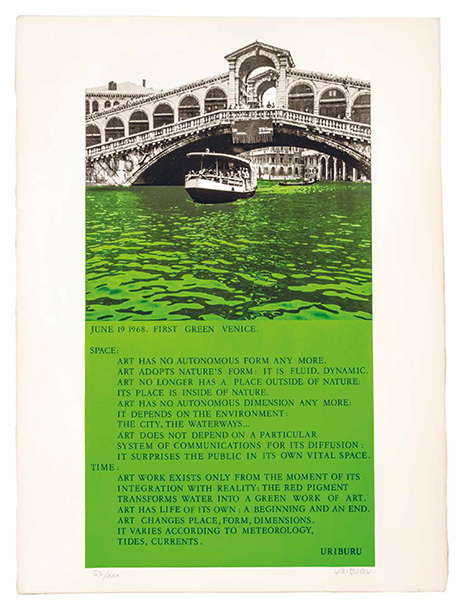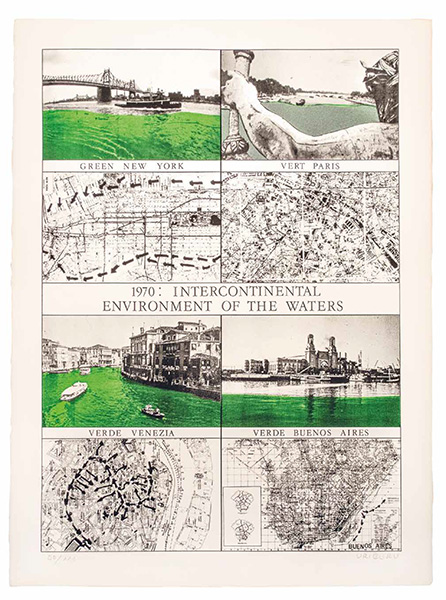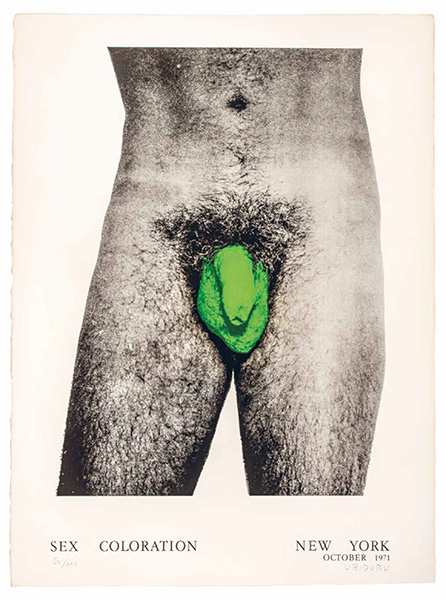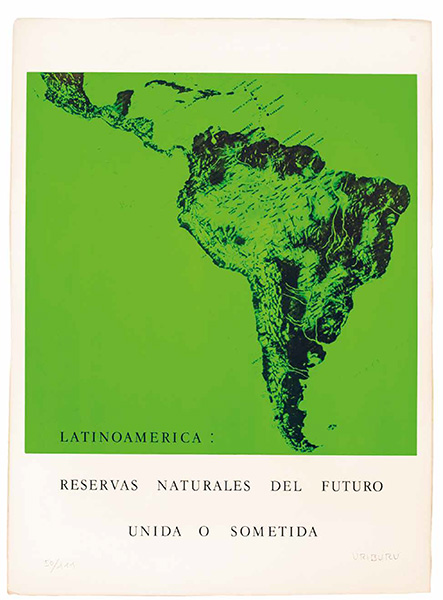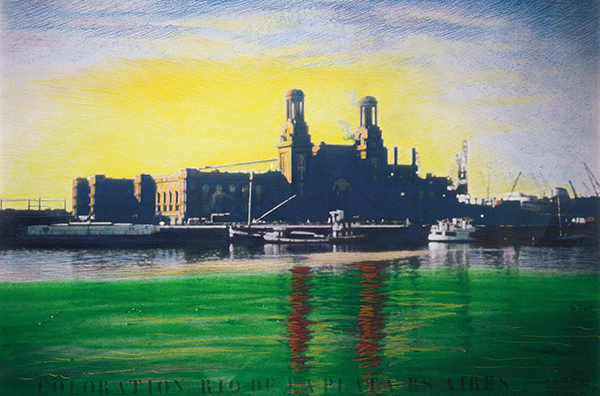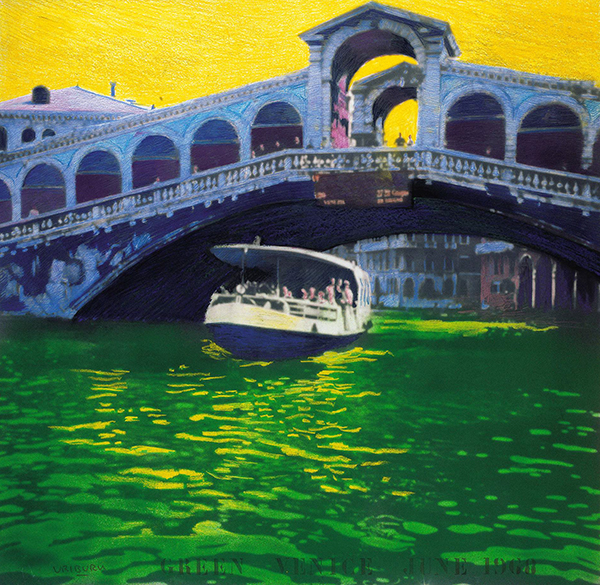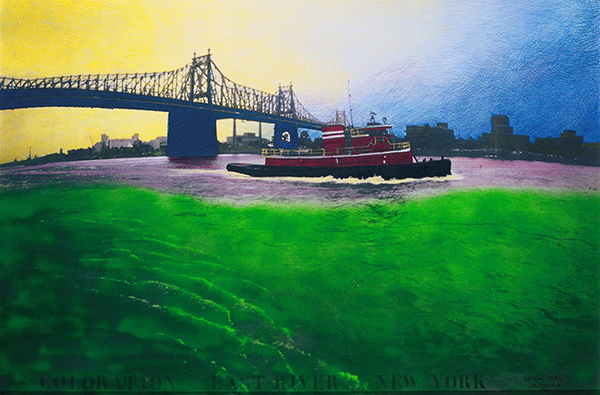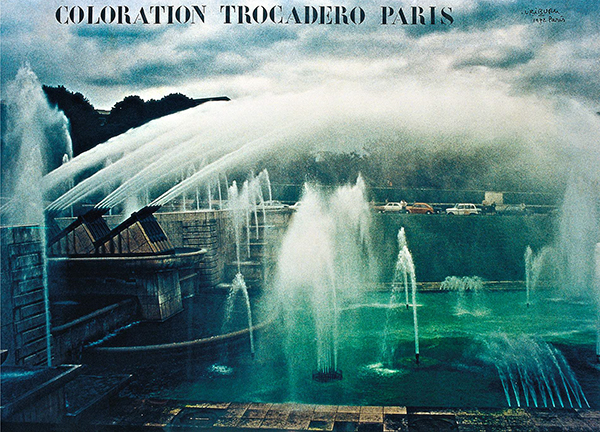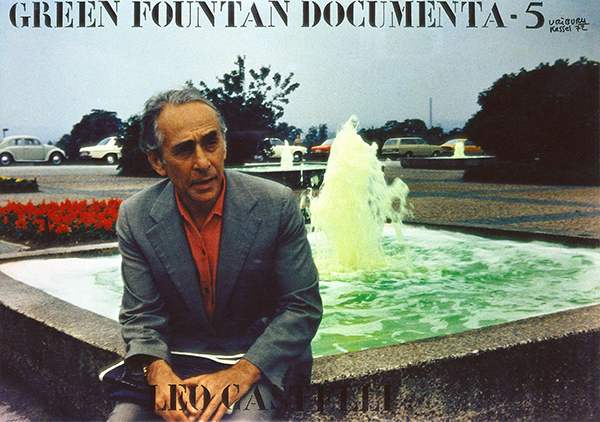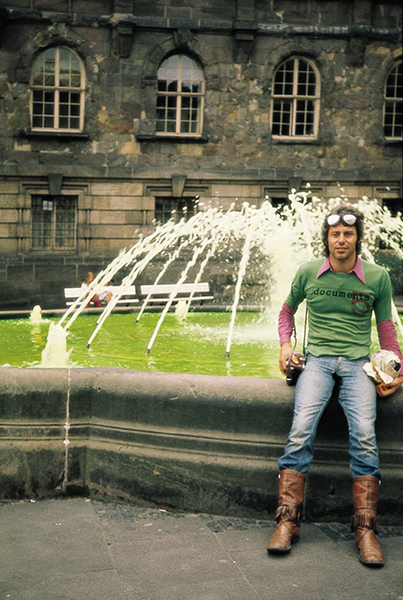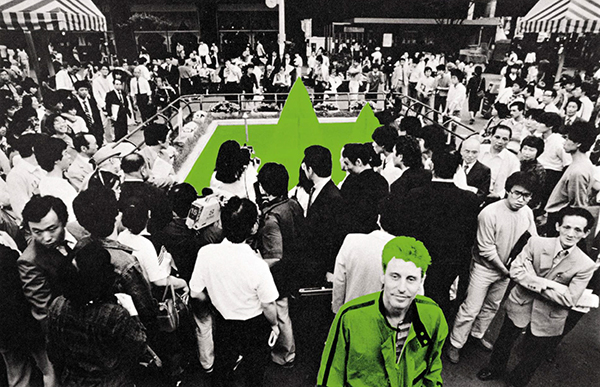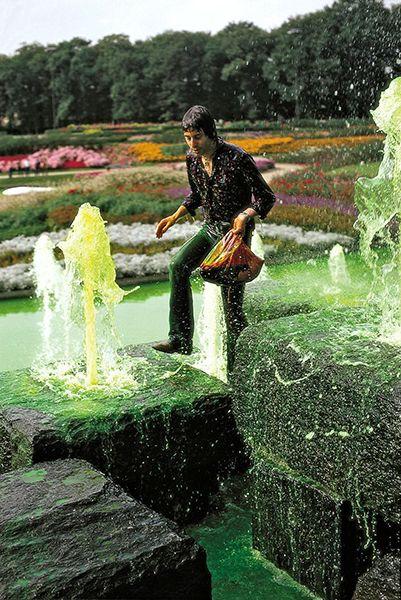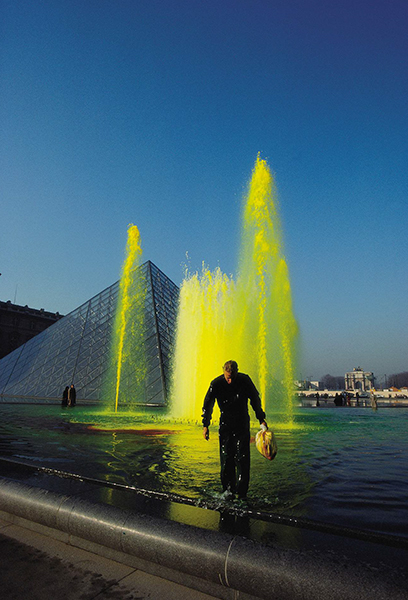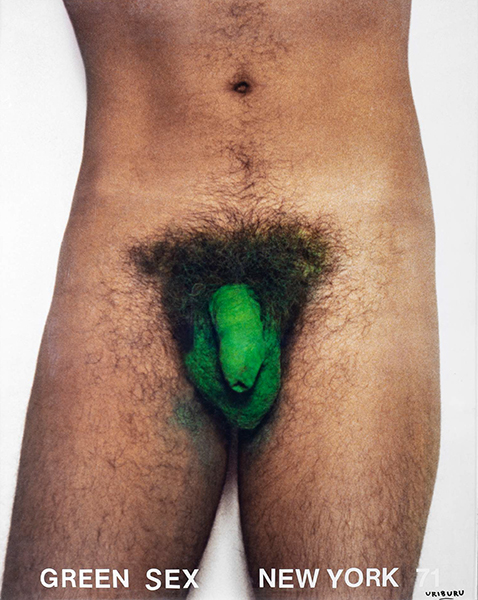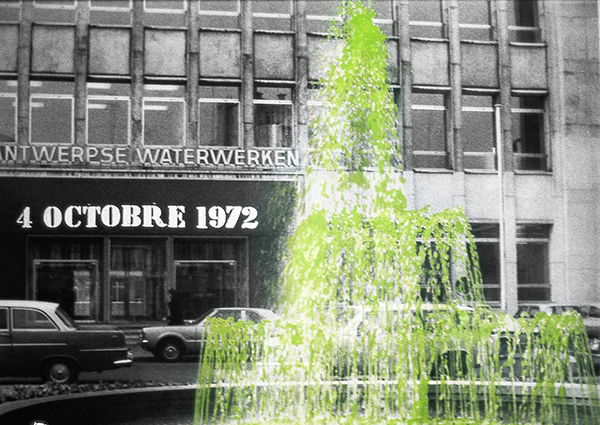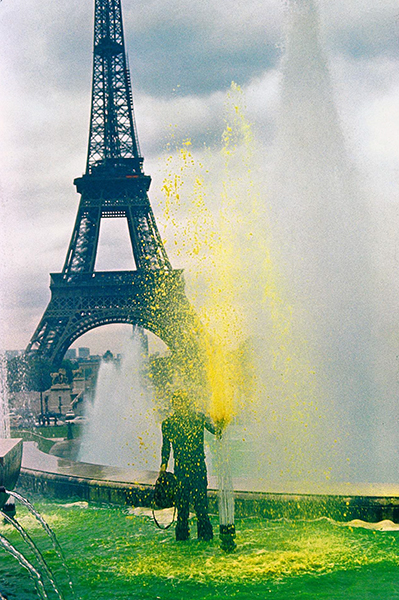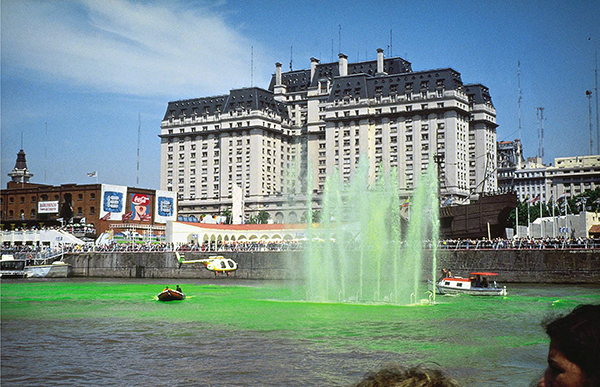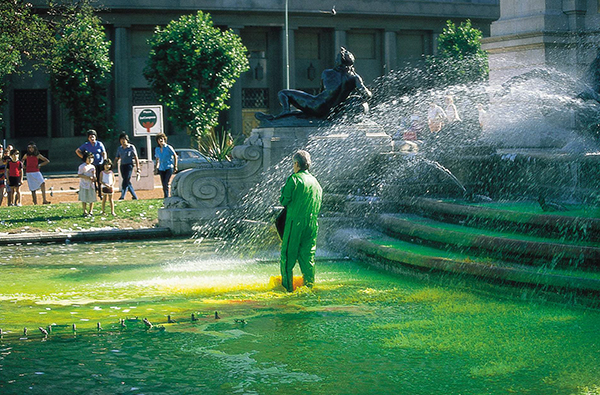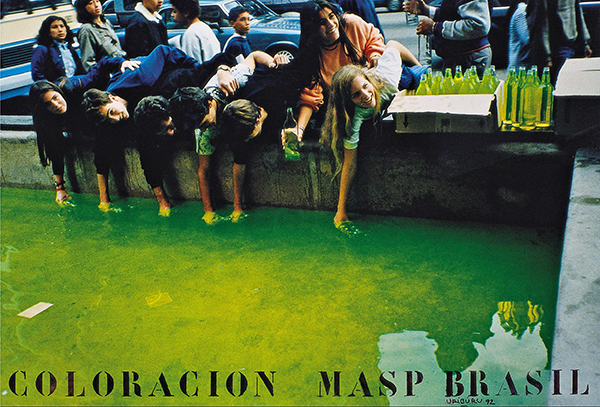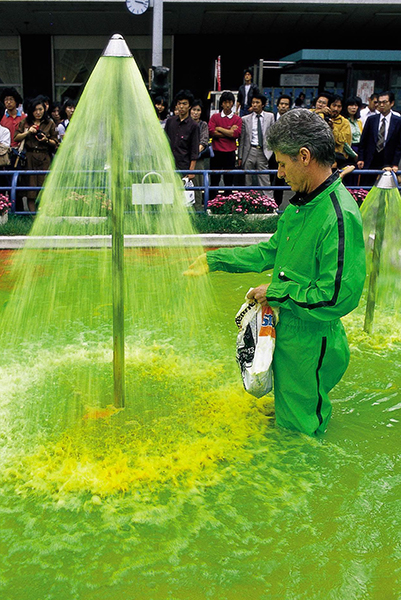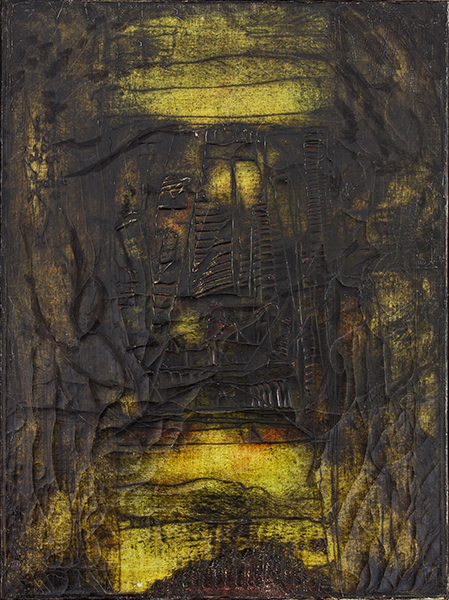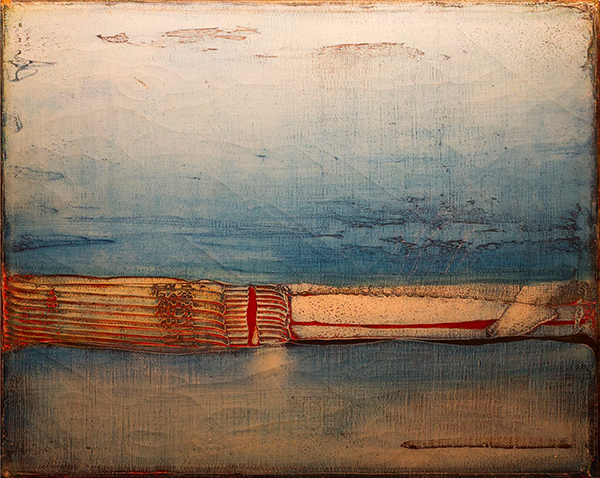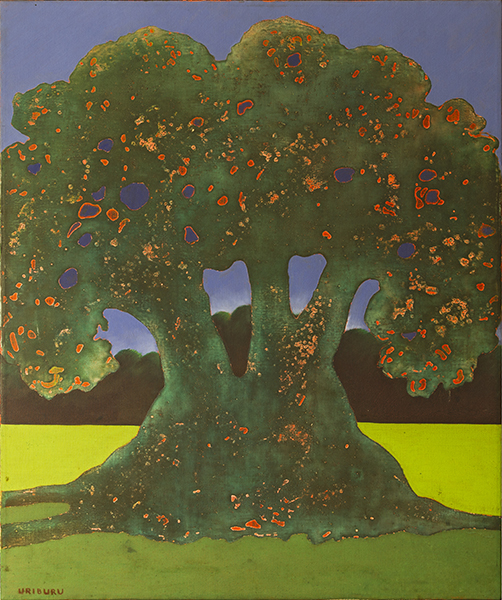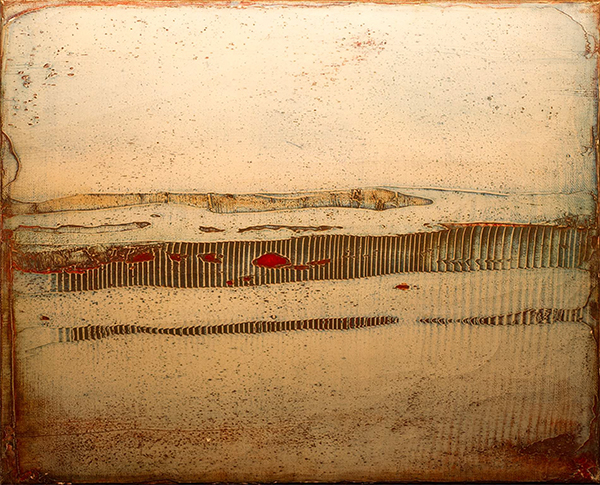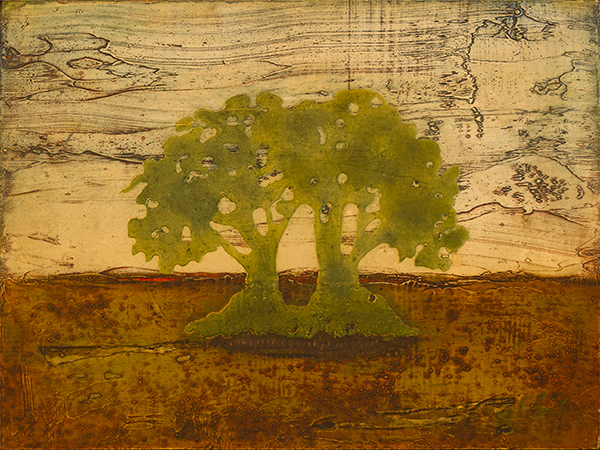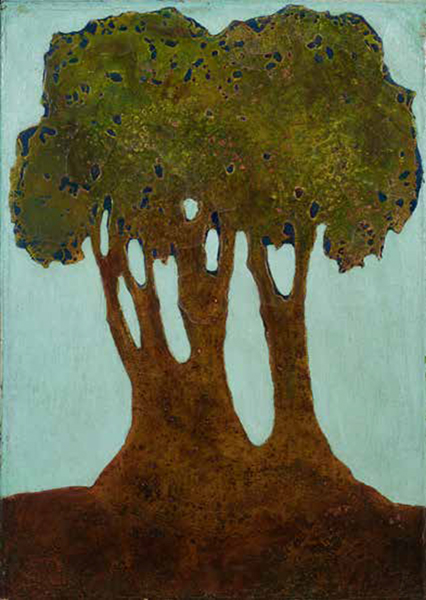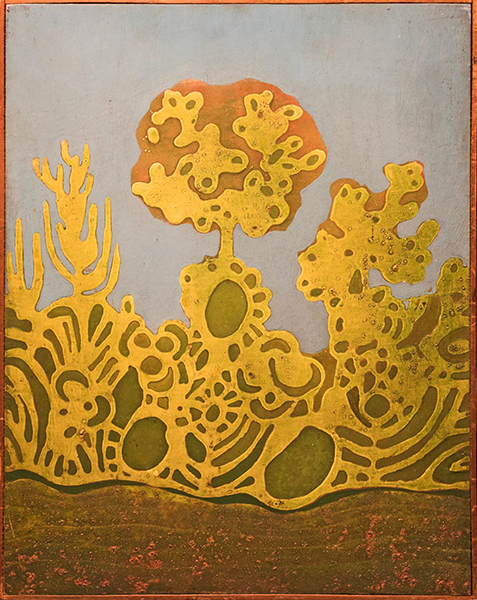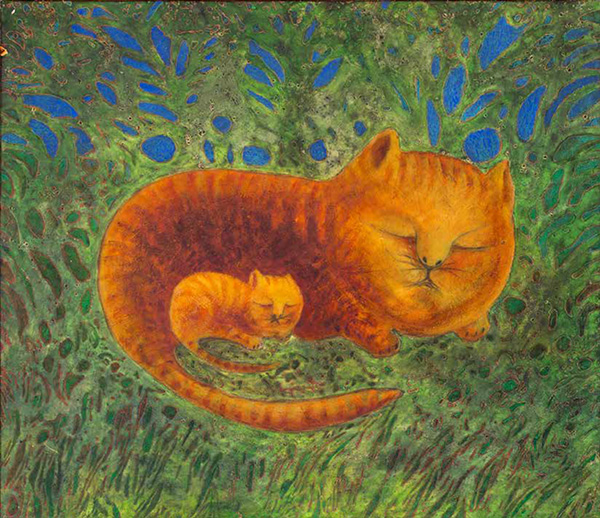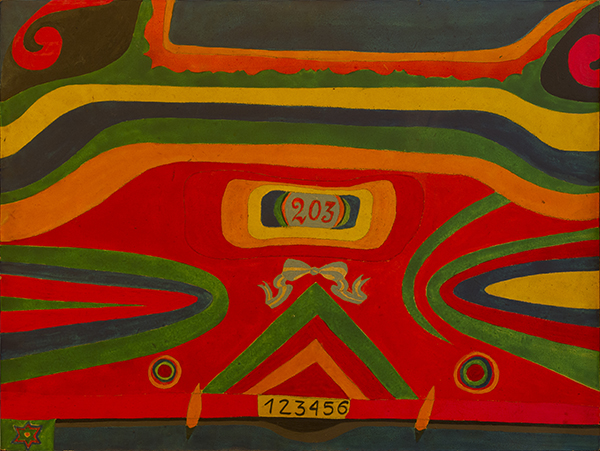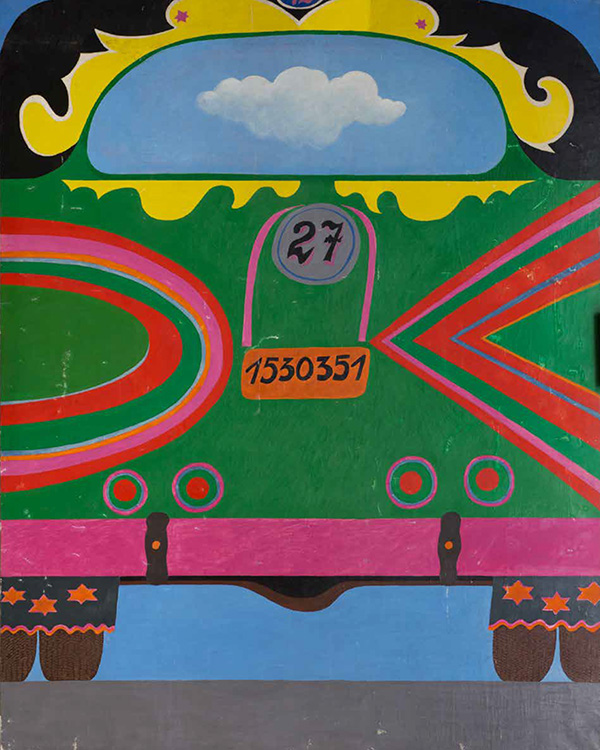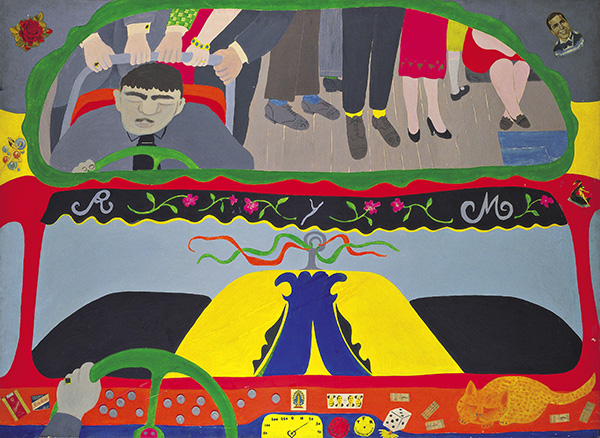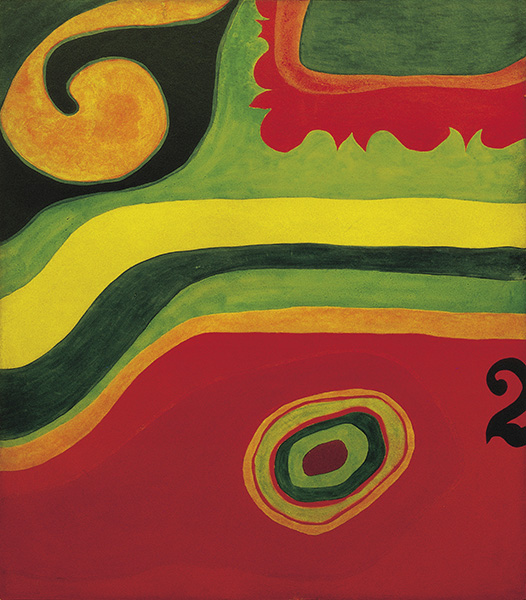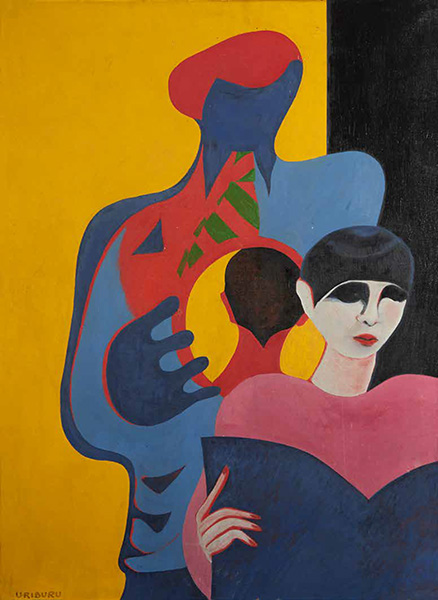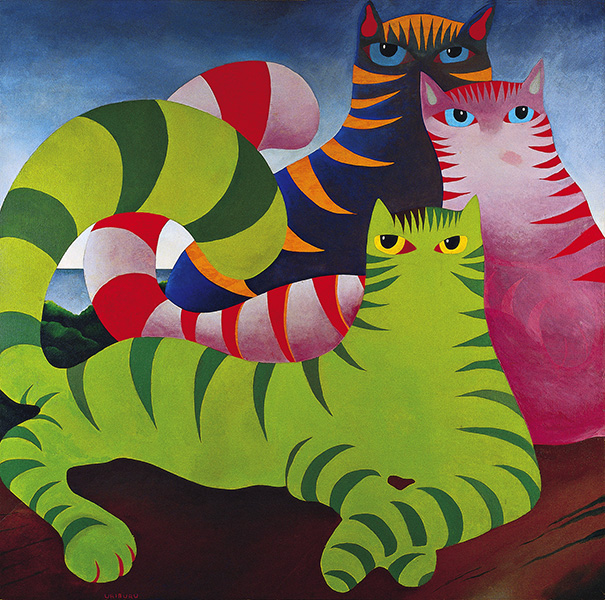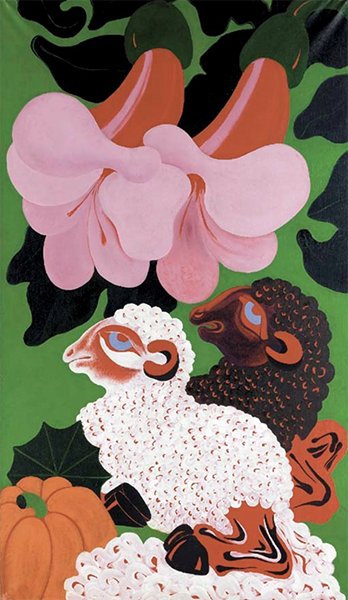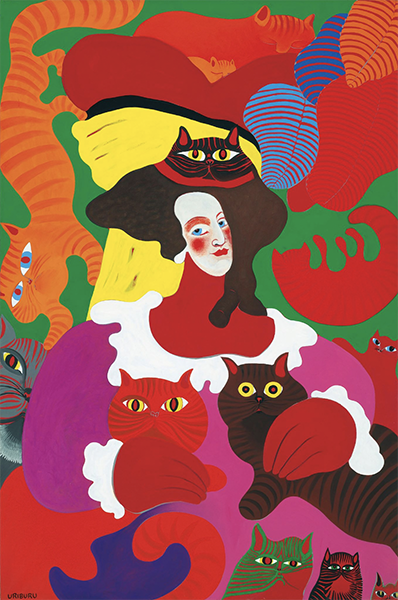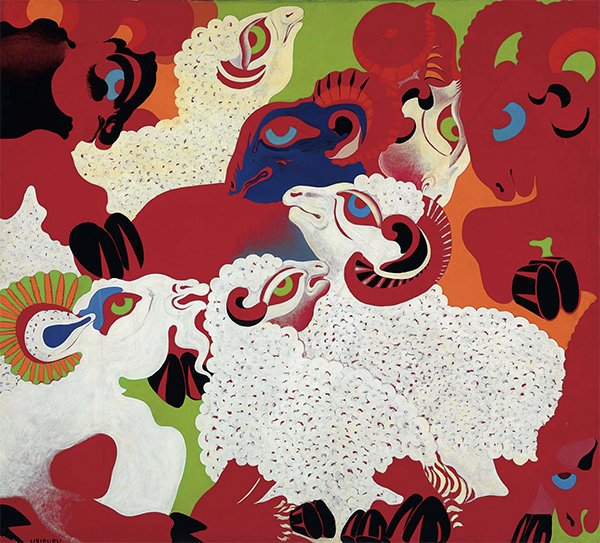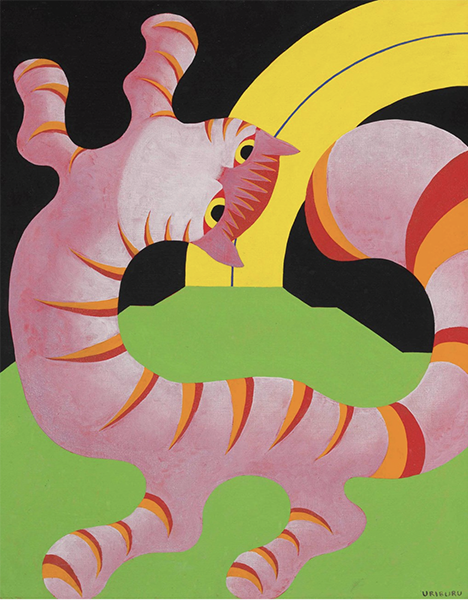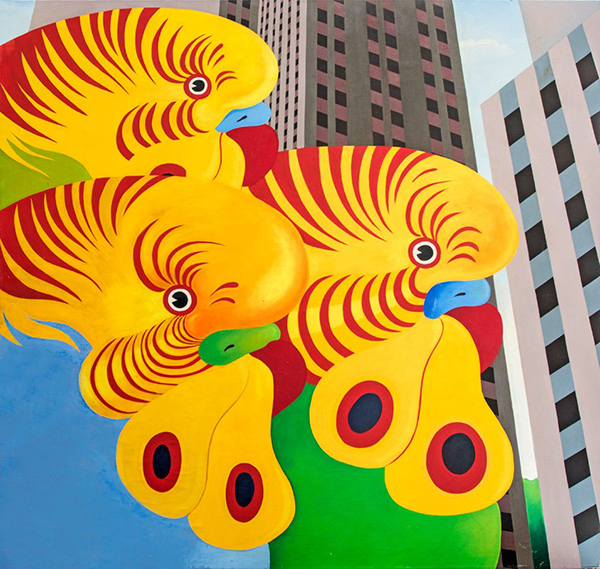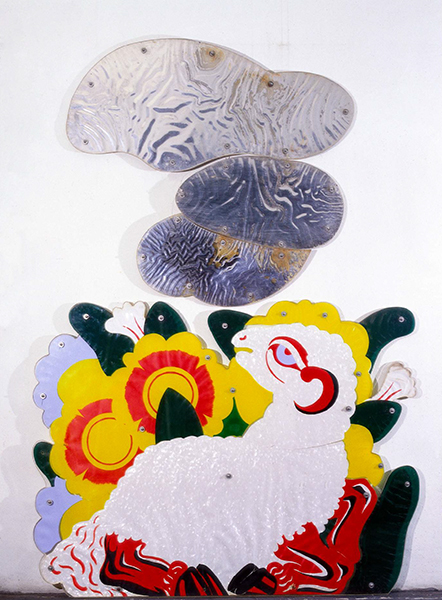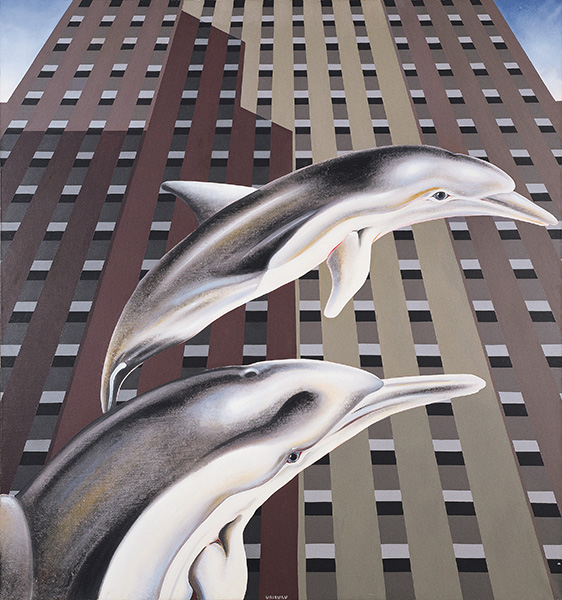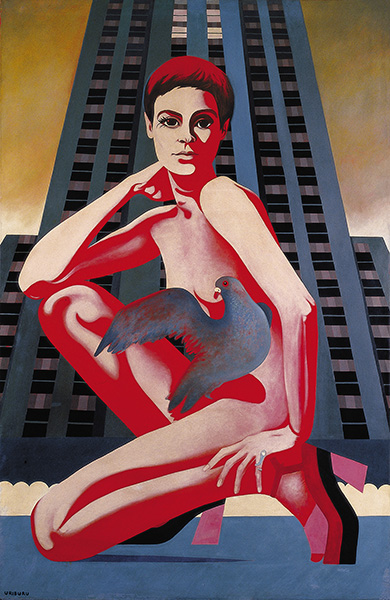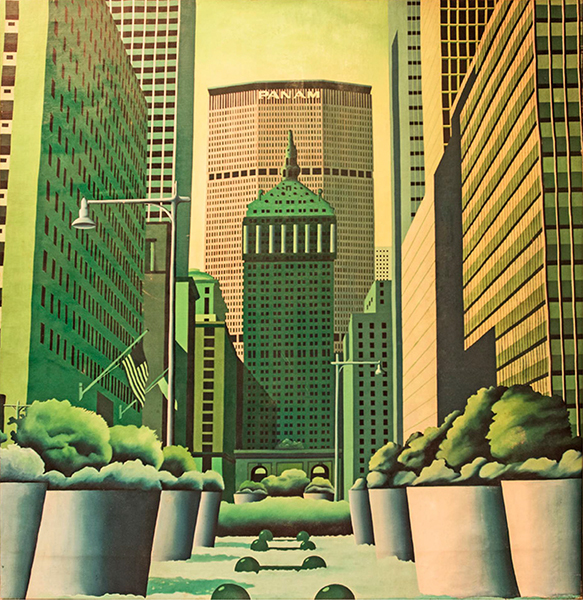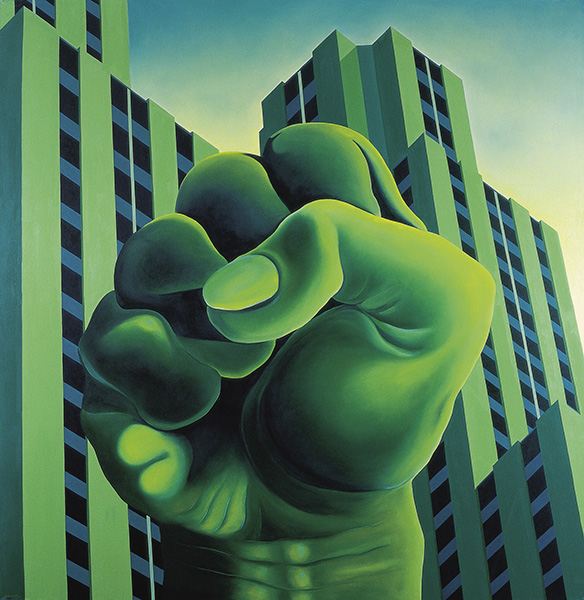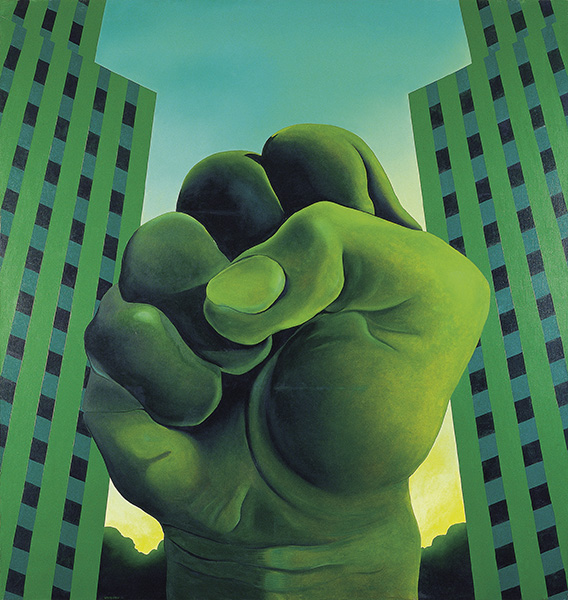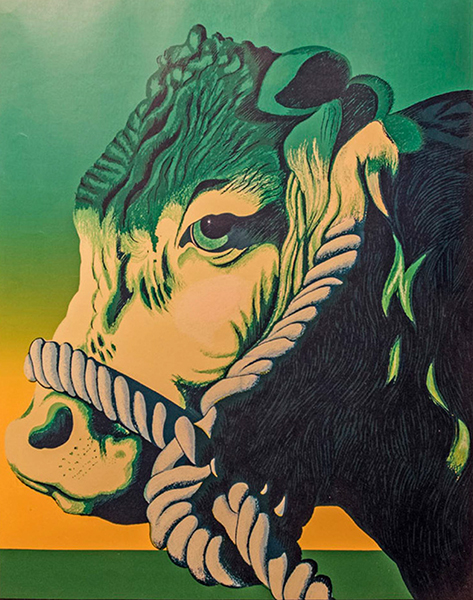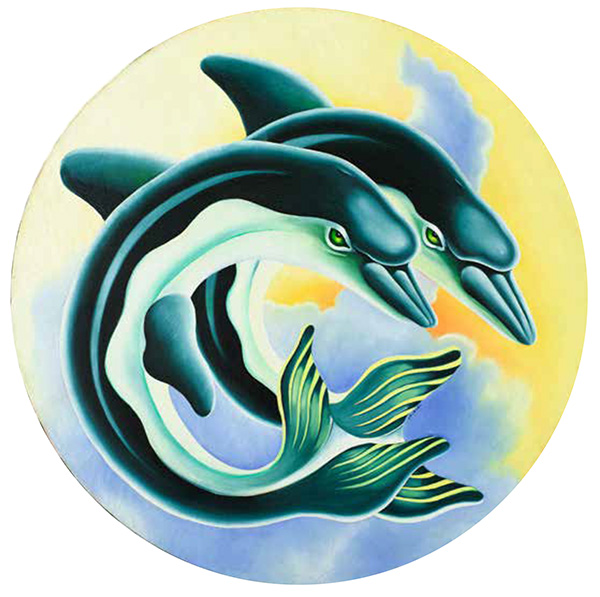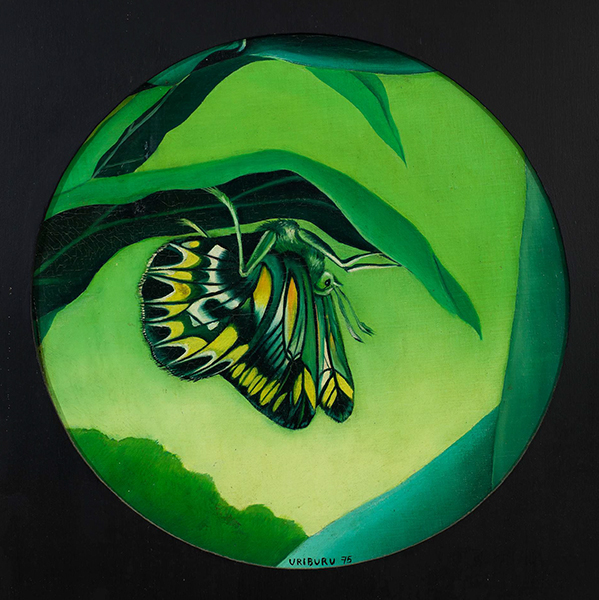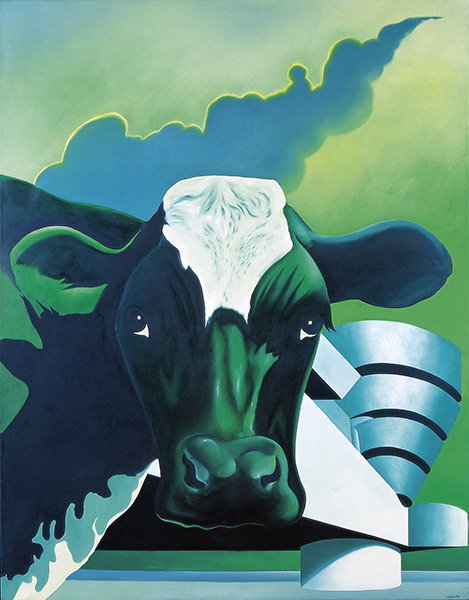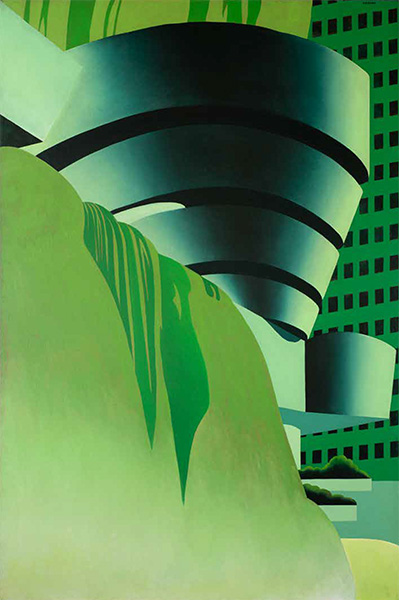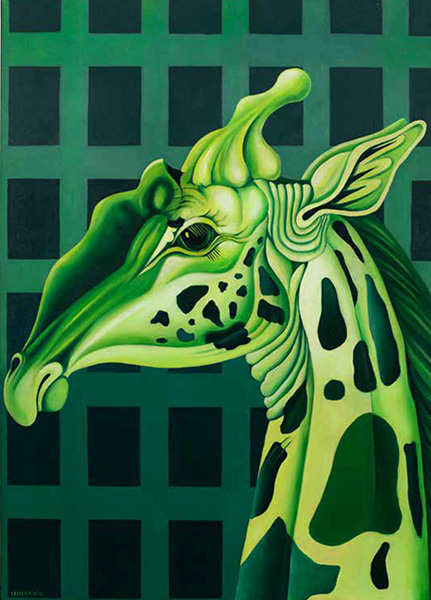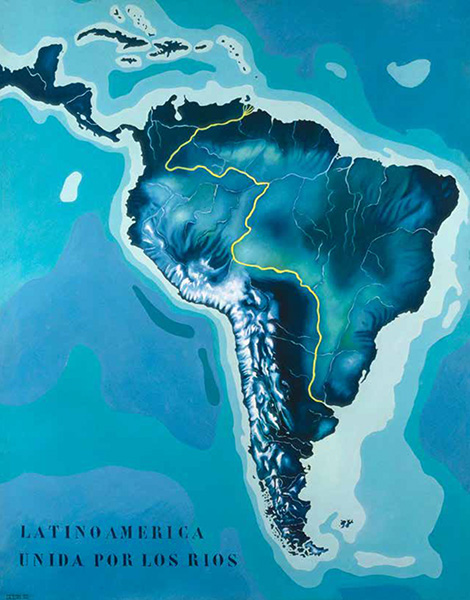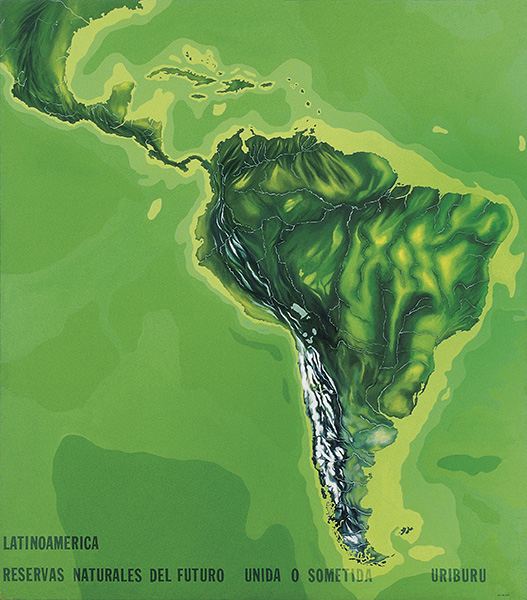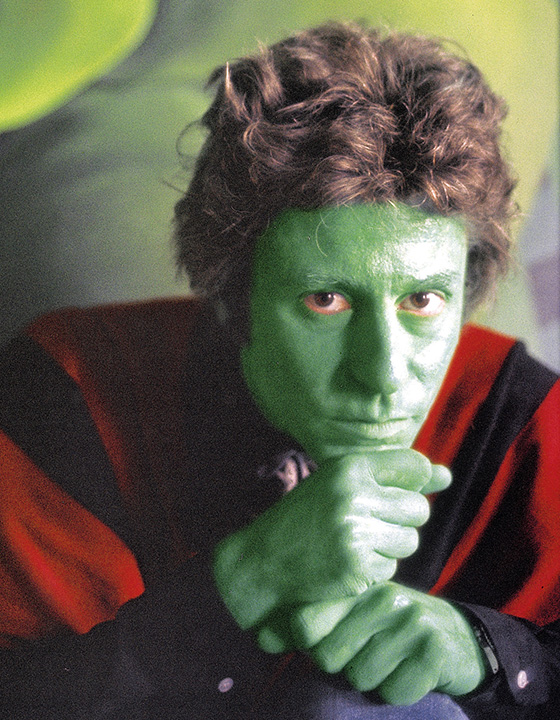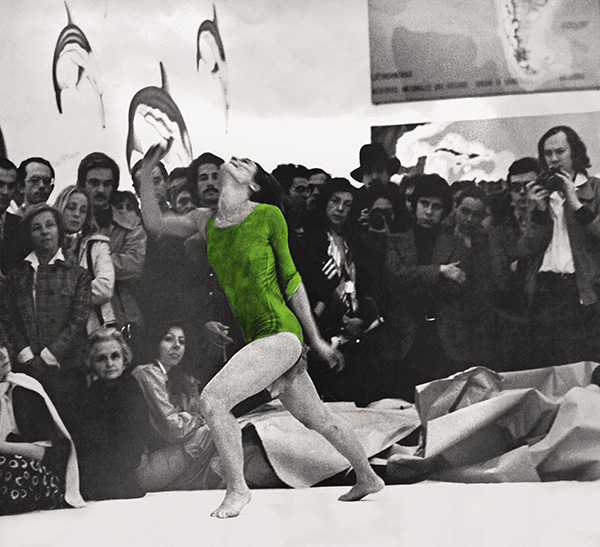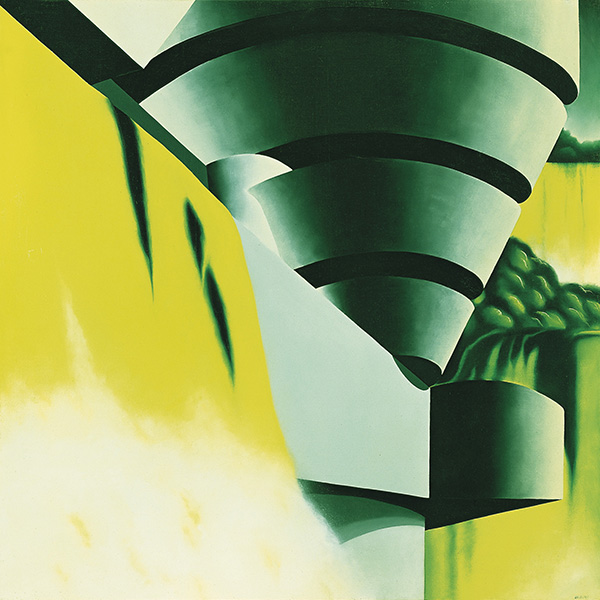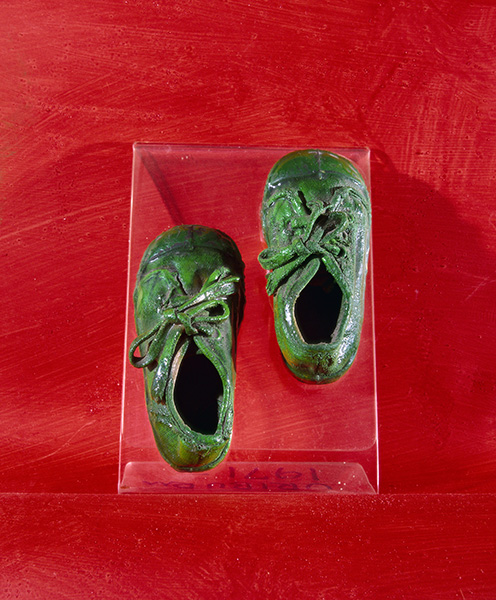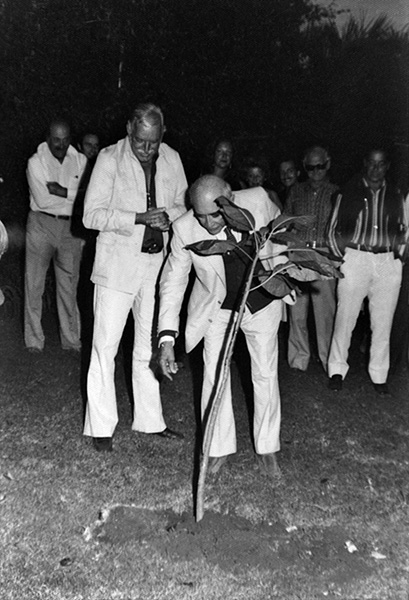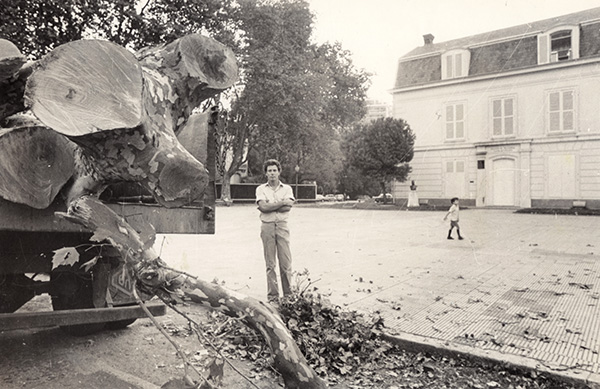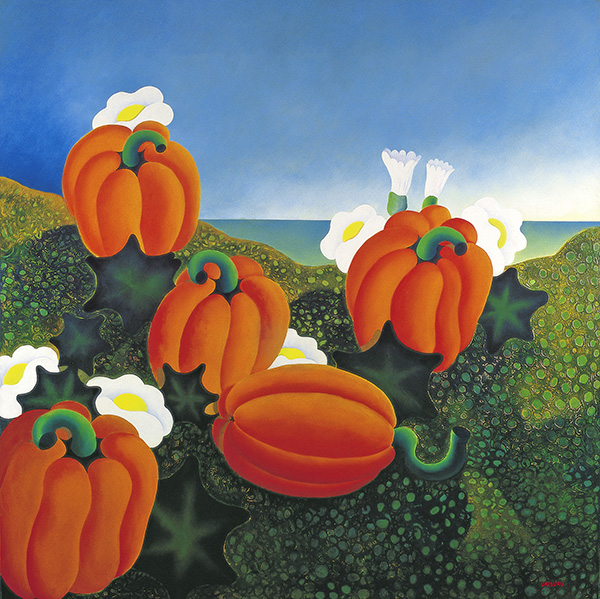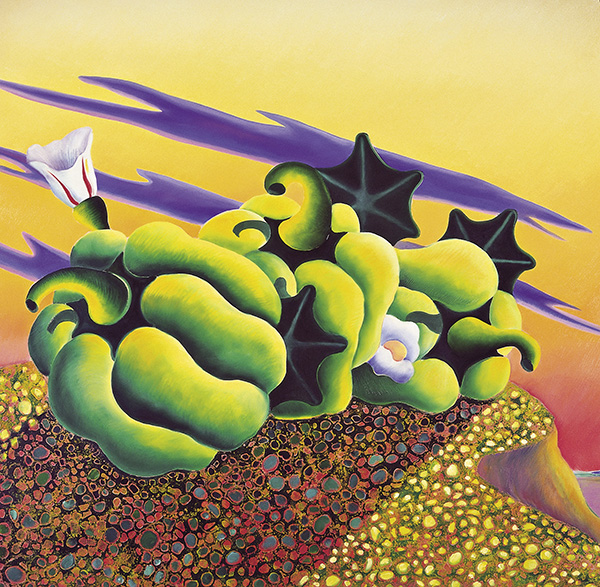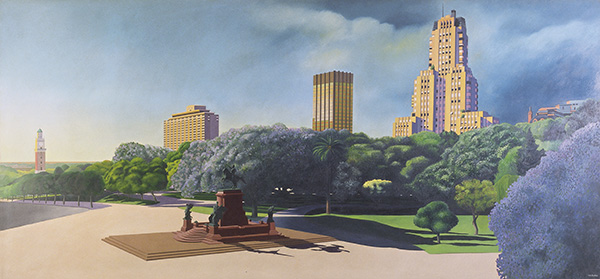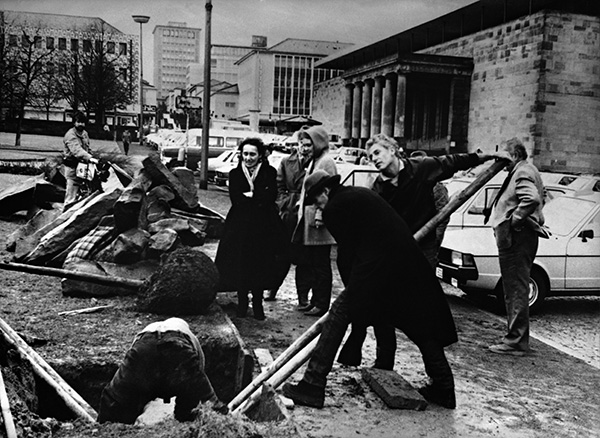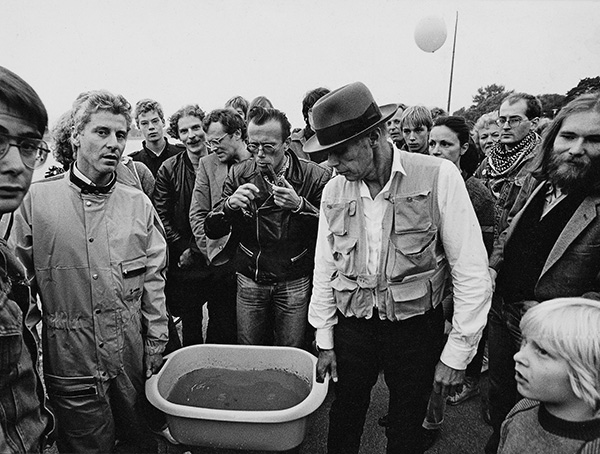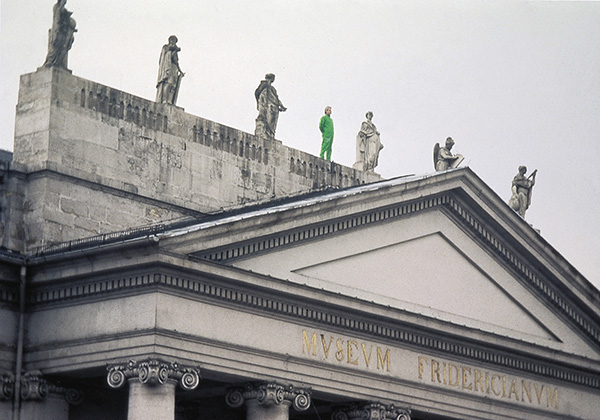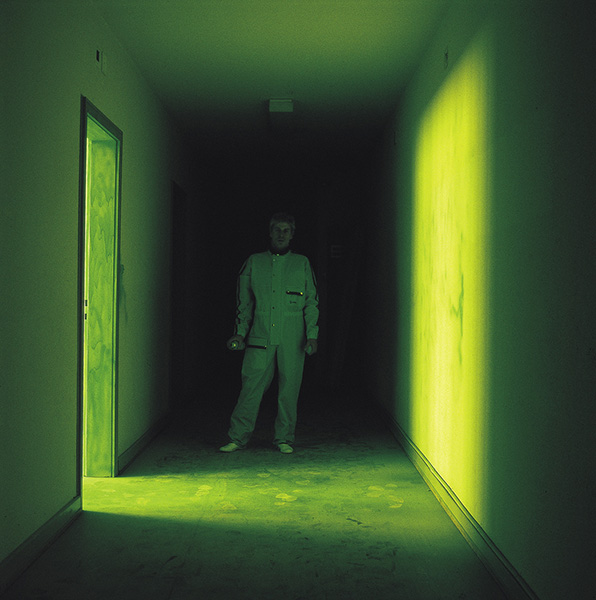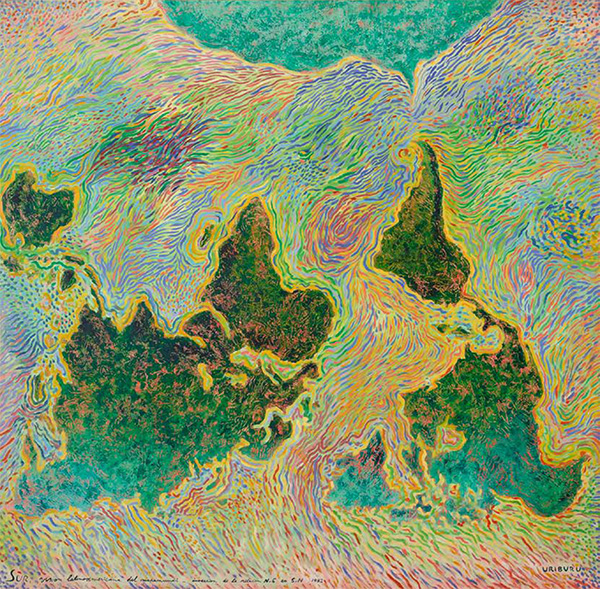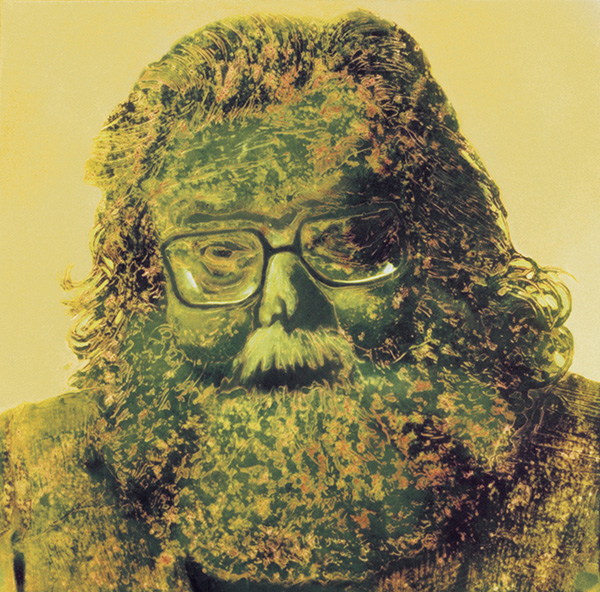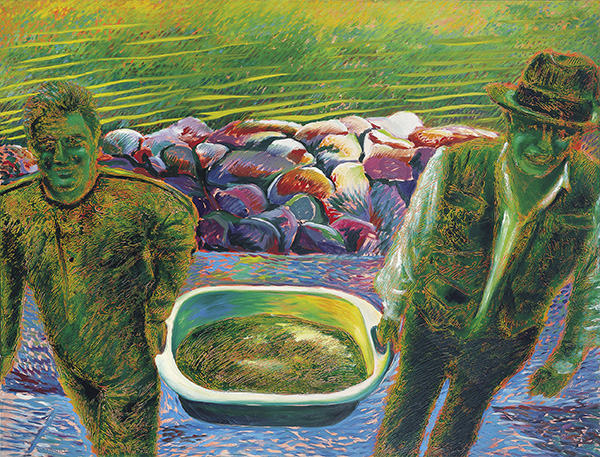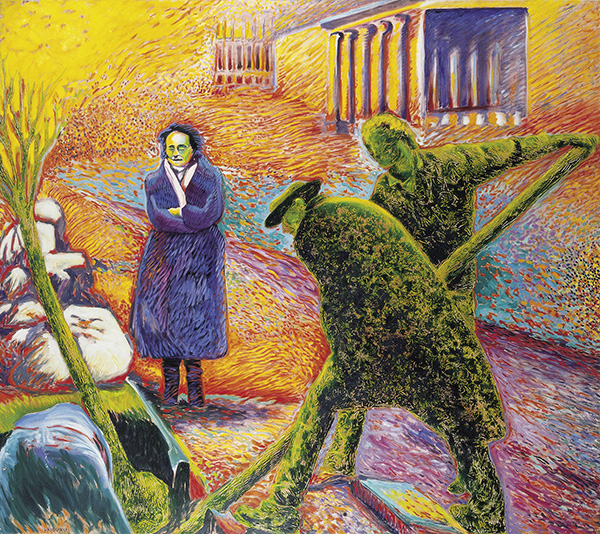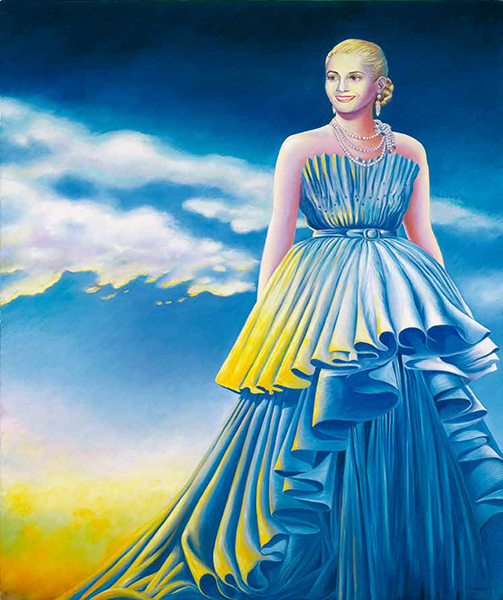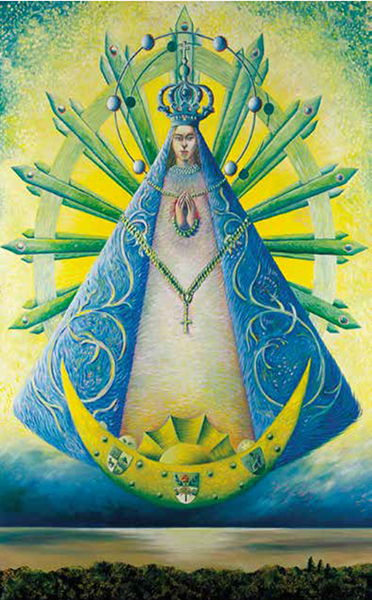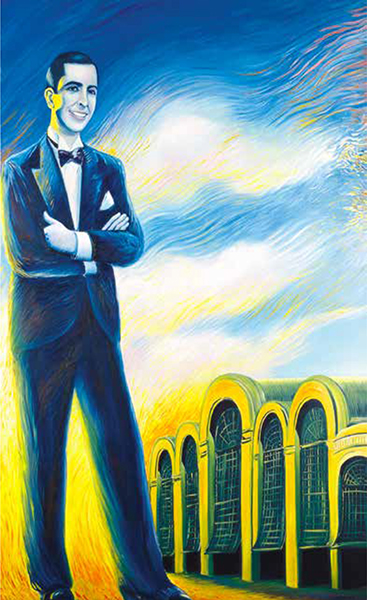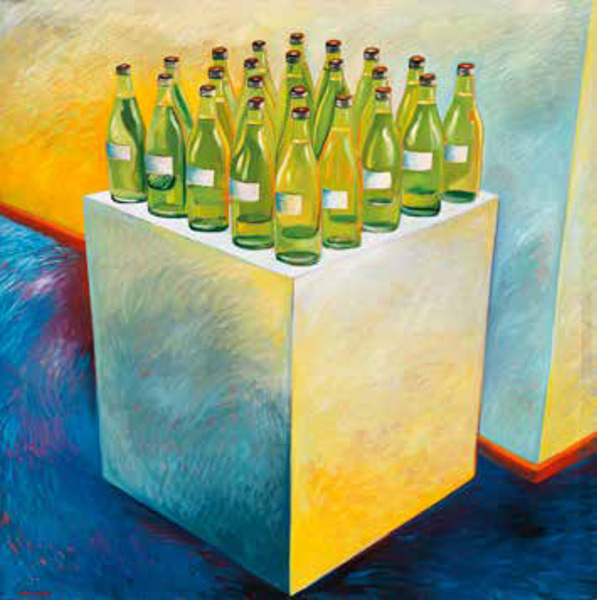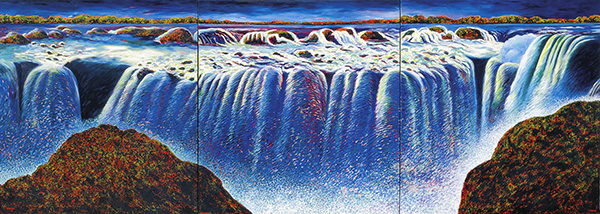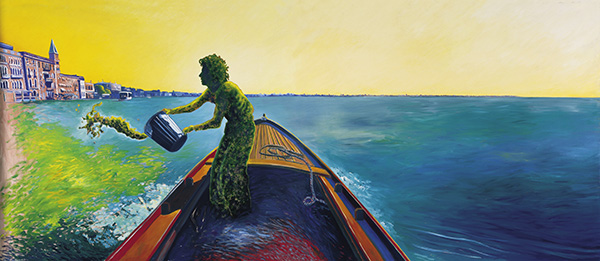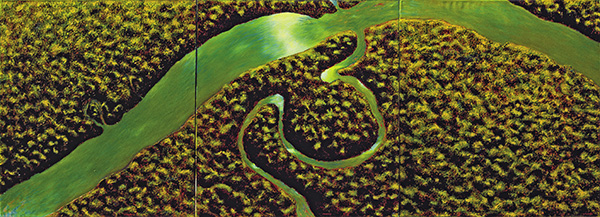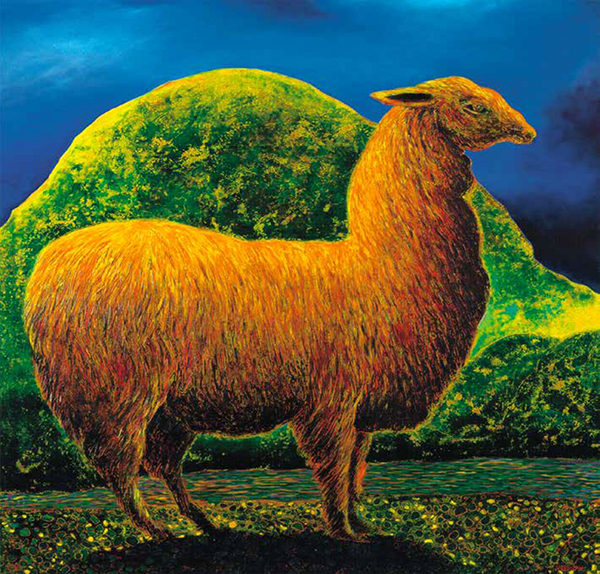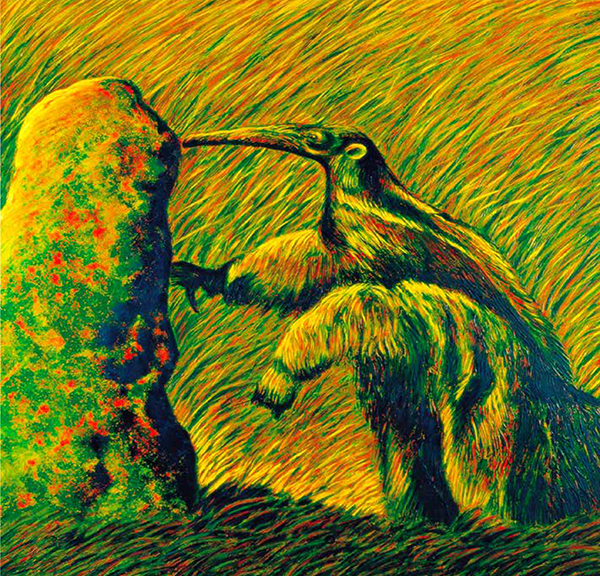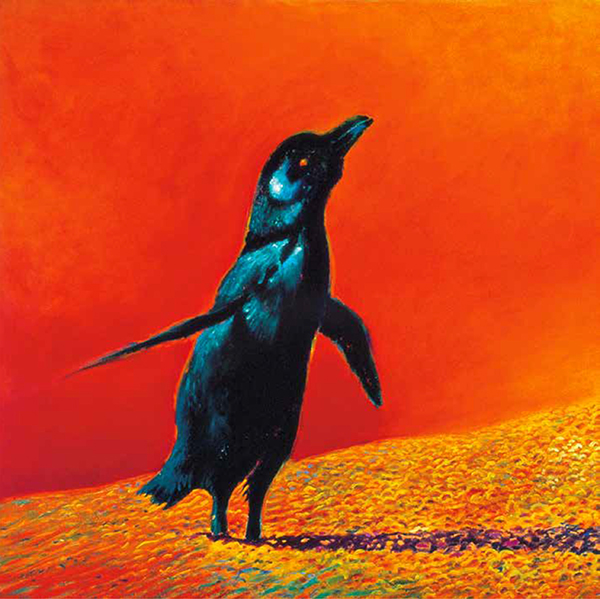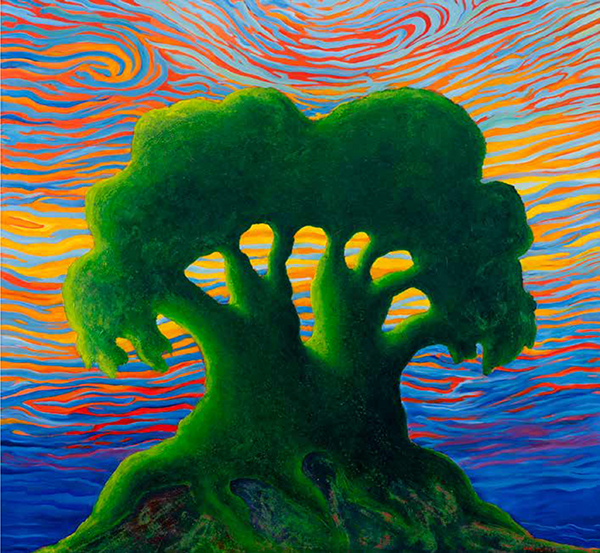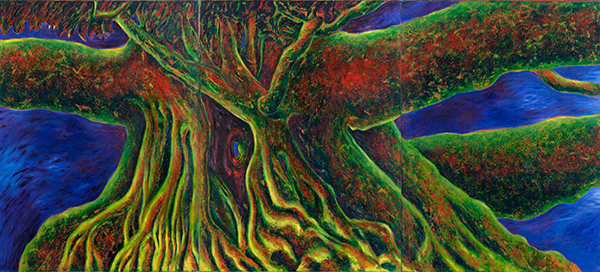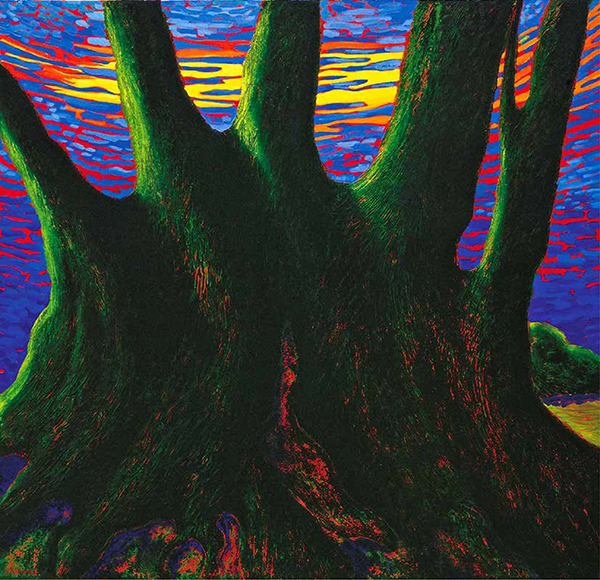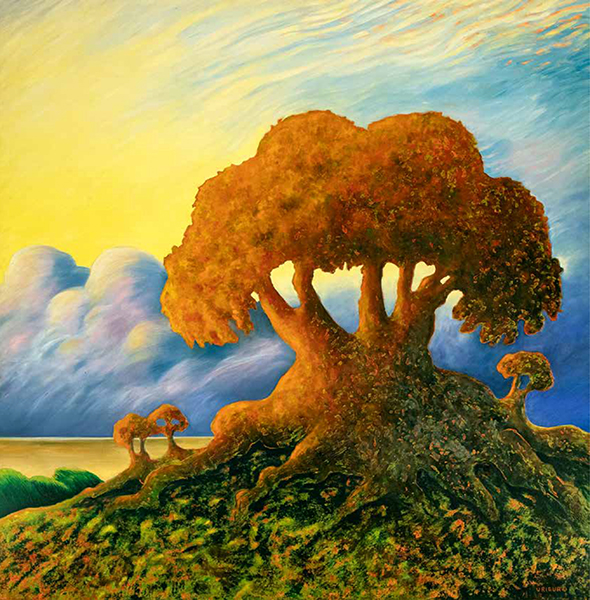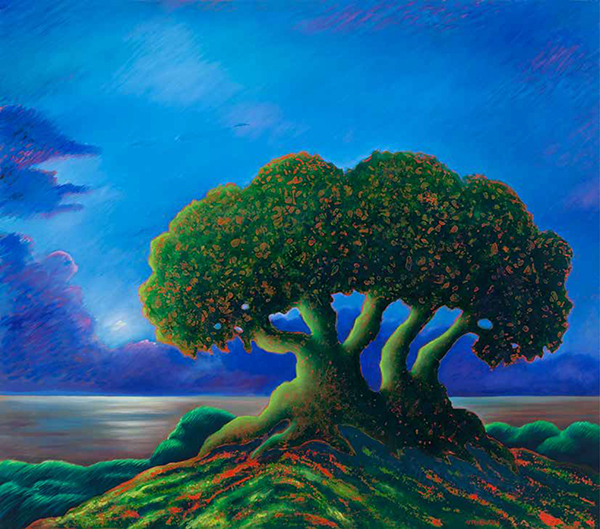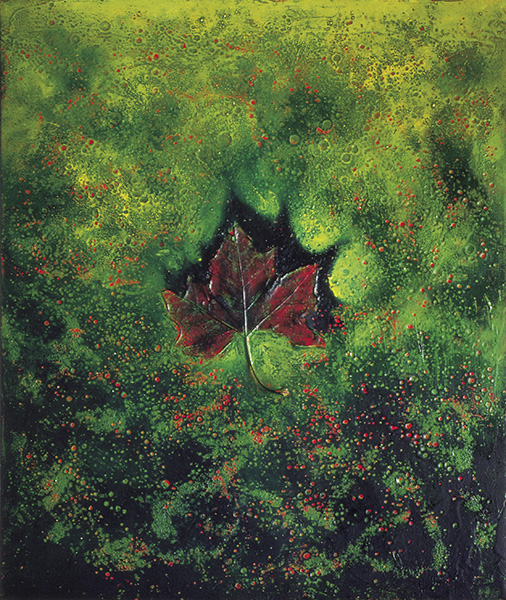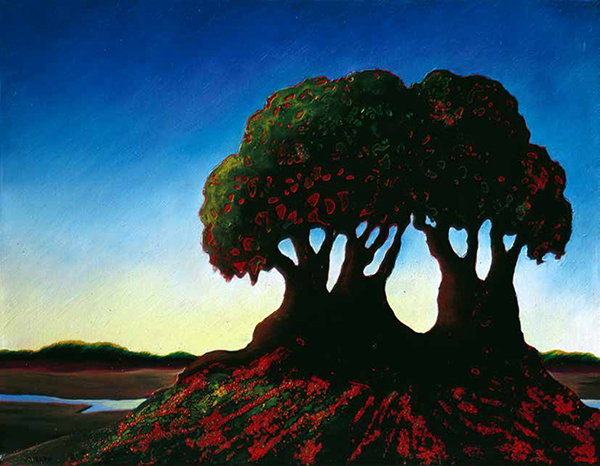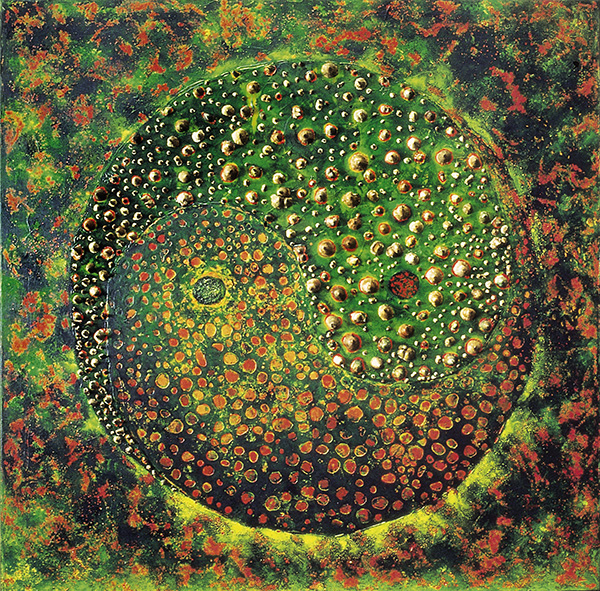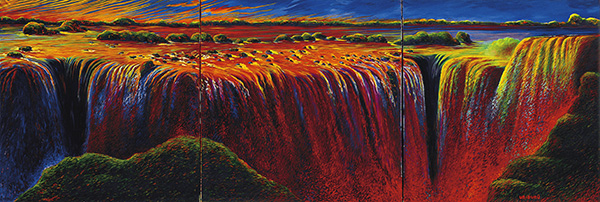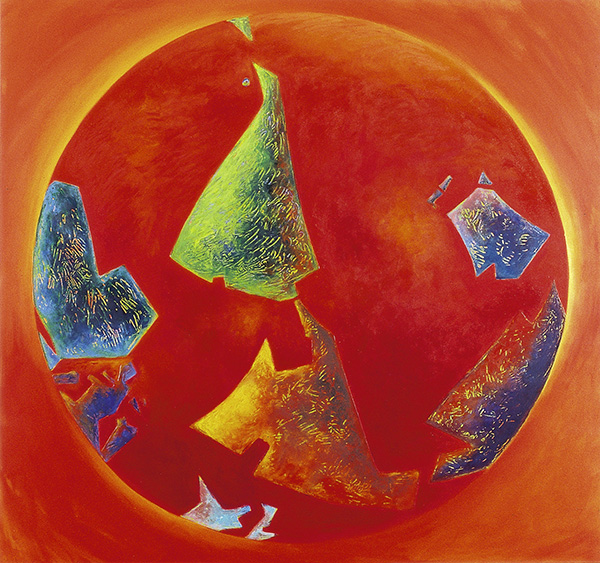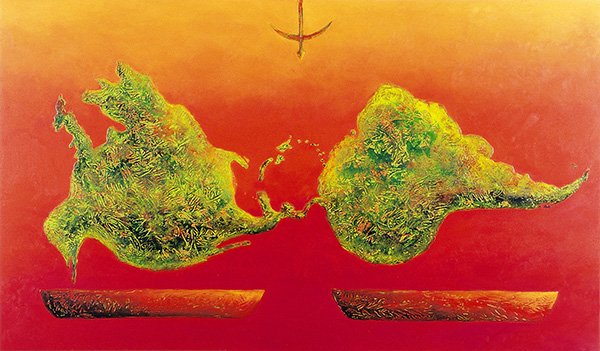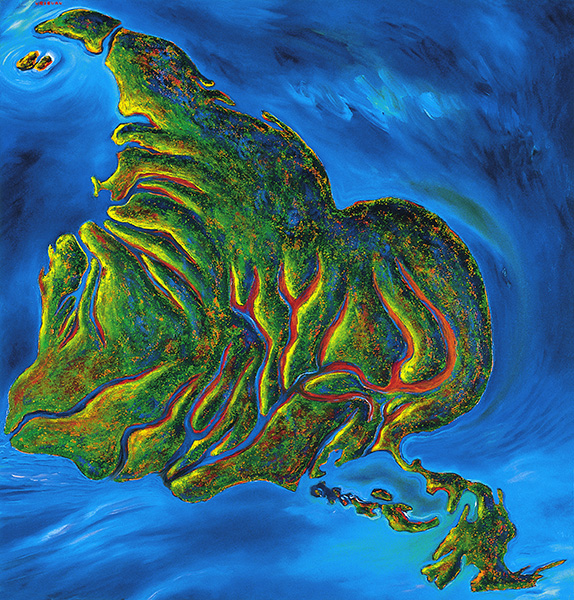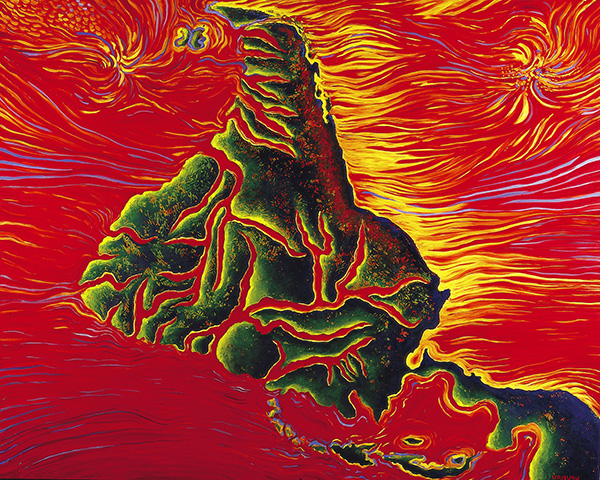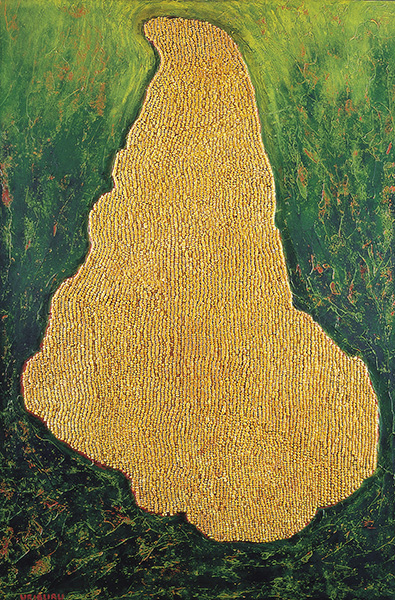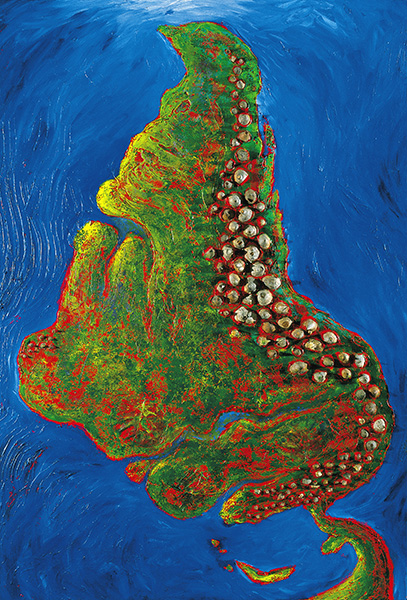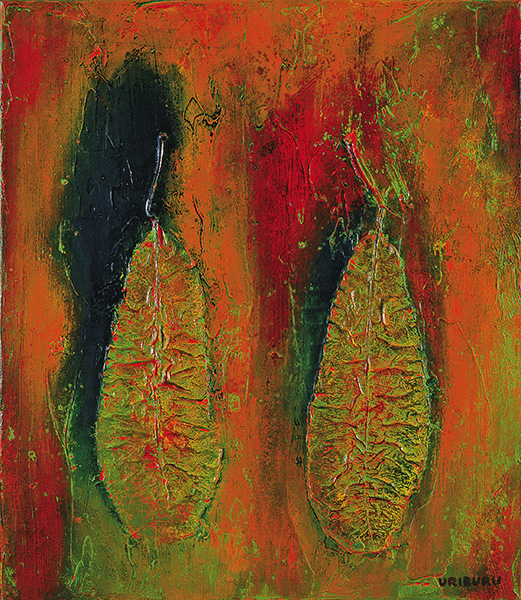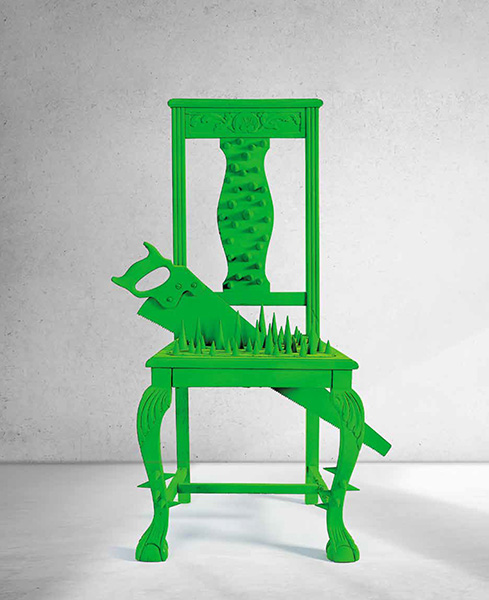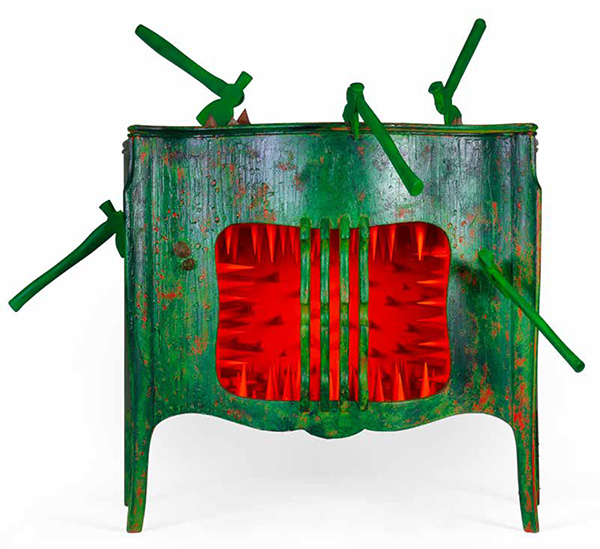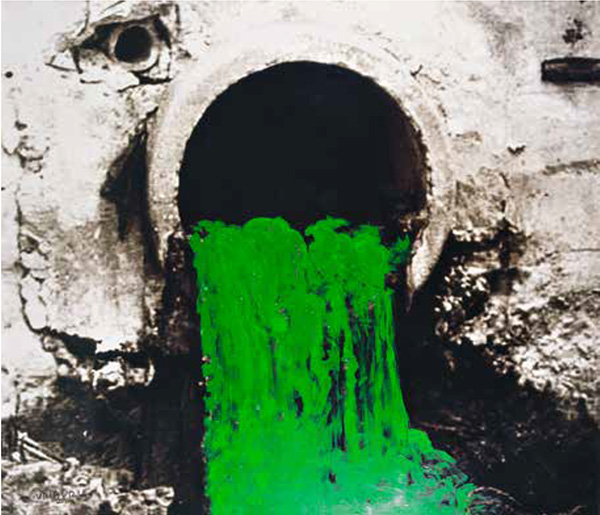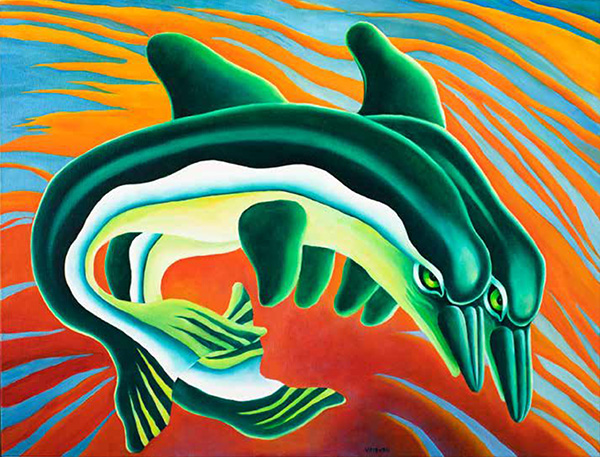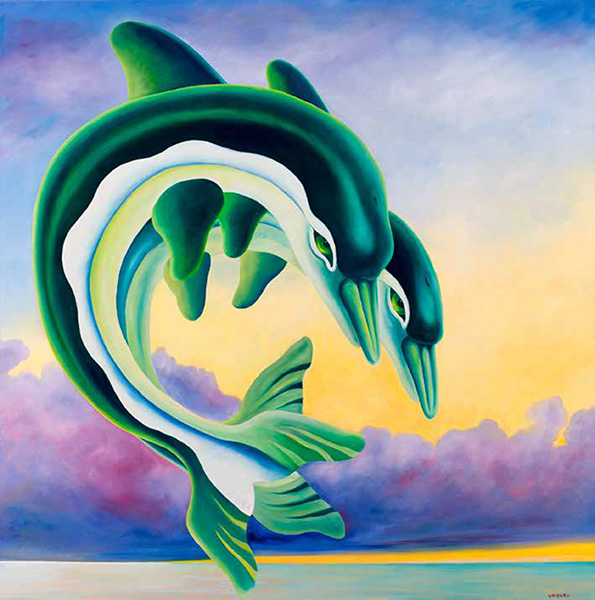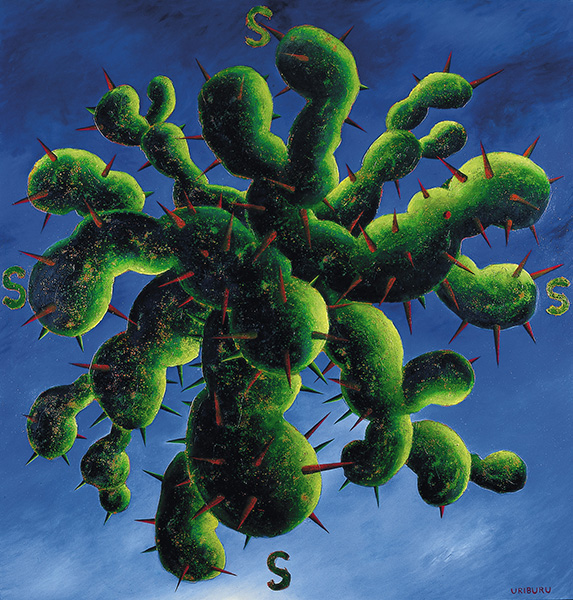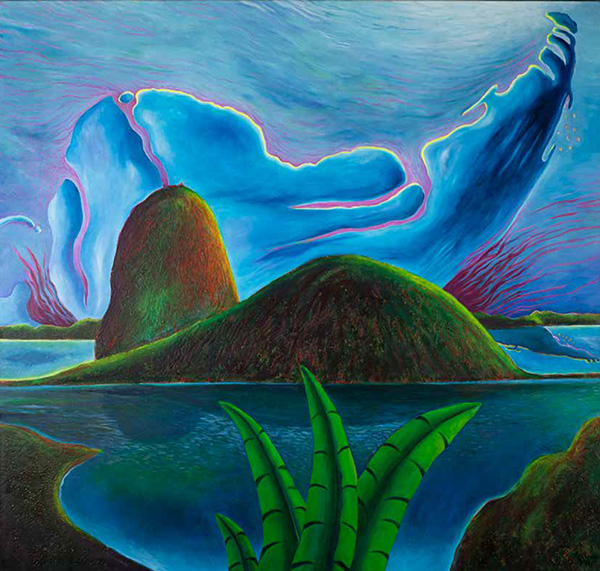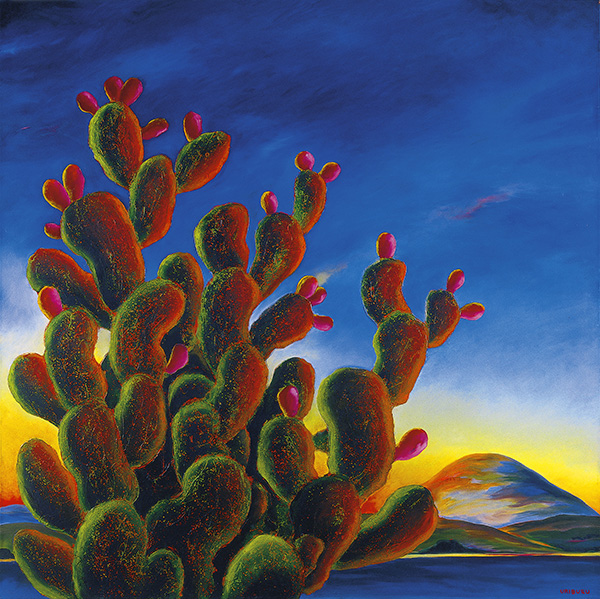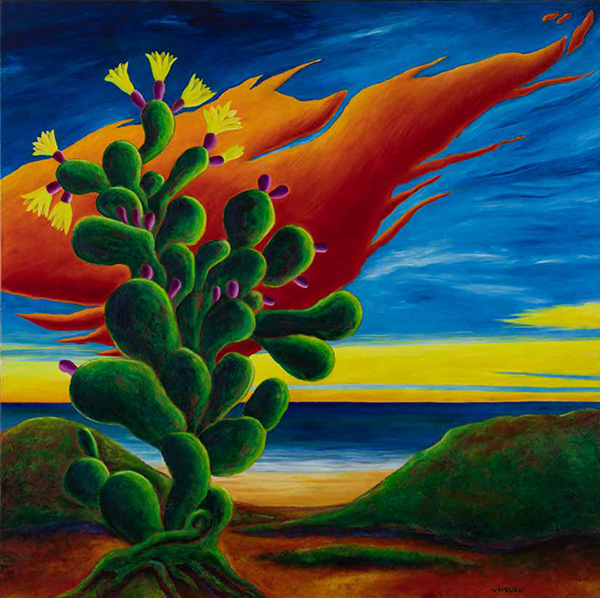Works
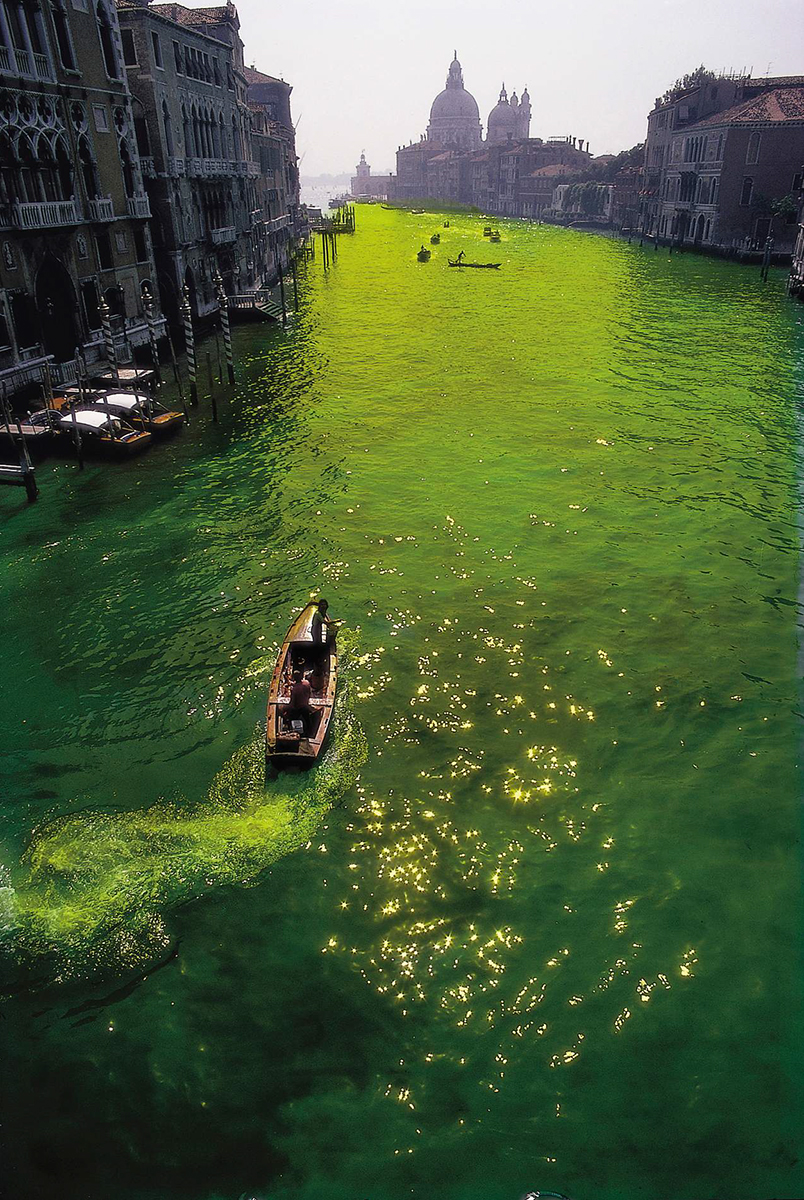
Coloration du Gran Canal, 1968
Photograph, 102 x 70 cm.
NGU Estate.
Colorations
“The inaugural intervention by García Uriburu – dyeing the waters of Venice green half a century ago, during (and behind) the Biennale – marked a turning point in the history of contemporary art. Not only in its ability to reflect on the ongoing ecological catastrophe but also in the role and ways in which art shapes the world. By providing alternative ways to visualize our actions, no longer as individuals but as a species, and by doing so with an impressive performance on an unprecedented support, the Argentine achieved an unparalleled impact that forever altered the perception of the connection between art and landscape.”
Andrés Duprat, Director of Museo Nacional de Bellas Artes.
In June of 1968, while the 34th Venice Biennial was under way, Nicolás García Uriburu carried out an action that would in time be understood as a pioneering experience in Argentinean and international art: he dyed the waters of the city’s emblematic backdrop, the Grand Canal, green.
Everything had begun a few months earlier, with tests done in the Seine from its shores on the outskirts of Paris. Uriburu had undertaken his first attempts at freeing painting from the canvas that contained it in that vicinity. The artist had been experimenting with different supports and methods since 1967 with this aim in mind. First, with a series of exhibitions at Iris Clert’s gallery, where he showed his work involving cut-out figures in acrylic hung on the walls, freed from the canvas, or with volumes distributed throughout the space (Prototypes for an Artificial Garden was one of these). Finally, he decided to leave the studio in order to intervene directly in nature.
He made his first trip to Venice in March of 1968, and there he began to plan the action, conceived from the very beginning as a “large scale environment”. As he would describe, he went there to “conscientiously [study] the ebb and flow of the tides, the degree of danger in the colorant, etc.”.2 In the city, he had also contacted several gondoliers, inviting them to collaborate in his large-scale water event. It was young Memo, a painter besides, who accepted the challenge of navigating with the artist while he carried out the coloration. And so a few days before the inauguration of the Biennial, García Uriburu, his wife, model Isabel Álvarez de Toledo, and famous painter Raquel Forner all took a train to Milan, where they set out to buy thirty kilos of Fluorescein before continuing on to Venice. The Paris they left behind was convulsed by the May 1968 uprising in France, which had coincided with the opening of his Prototipos para un jardín artificial show.
However, far from leaving the disturbances in France behind, Uriburu encountered a Venice in upheaval with the repercussions of the conflicts in the French city. Daniel Cohn-Bendit, the leader of the Parisian revolts, had gone there with over one thousand students from different European capitals, and they were denouncing the biennial as a “middle-class monopoly on art”.In addition, local students had occupied the Academy just a few days earlier. The number of incidents multiplied, and repression of them went along in crescendo. Nevertheless, Uriburu did not call off the action. At eight o’clock in the morning on Tuesday, June 19, he boarded the gondola along with Memo and Ugo Mulas, a photographer sent by Domus magazine to record the activities of the Biennial. Blanca followed closely in another gondola, also taking photos: first, from the water and later positioned atop the Rialto Bridge. By her side, her faithful mascot Beto witnessed the whole event.
The action lasted between fifteen and twenty minutes. Then, the artist and the gondolier were detained and taken to Milan, suspected of manipulating dangerous substances. They were held for twelve long hours until a scientific committee certified that the Fluorescein was innocuous, and then released.
It was, effectively, a nonreactive substance that had several applications at that time: NASA used it in splashdown landings for its modules returning from space and it was also frequently used in the field of ophthalmology to carry out examination of the inner eye.
Upon his return to Venice, Uriburu did not find the state of alert that had invaded the city in the face of the uncertainty of a possible act of terrorism. The fear had dispelled. The atmosphere was one of jubilation, and the artist celebrated as he had transformed the city itself into an aesthetic event. The coloration that had turned the waters green during some eight hours had also dissipated by then. The artist explained his gesture as “an artistic phenomenon on a natural scale where the public navigates the work”.
With his coloration, García Uriburu had redefined the concept of landscape by introducing contemporary discussions from the art field such as those related to performance, Action Art or Body Art into the genre.
© Copyright Venecia en clave verde. Nicolás García Uriburu y la coloración del Gran Canal. Curator: Mariana Marchesi.
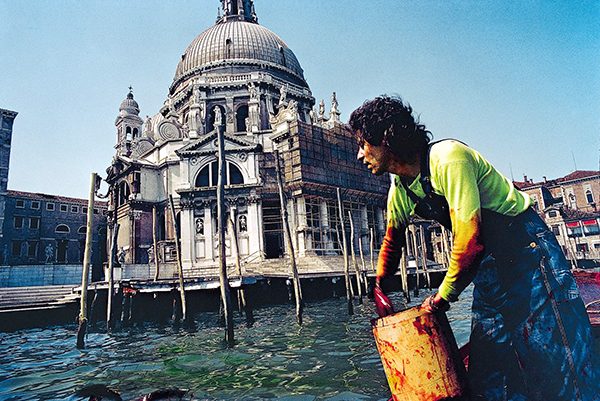
Coloration du Gran Canal, 1968
Photograph, 70 x 103 cm.
NGU Estate.

NGU Estate.
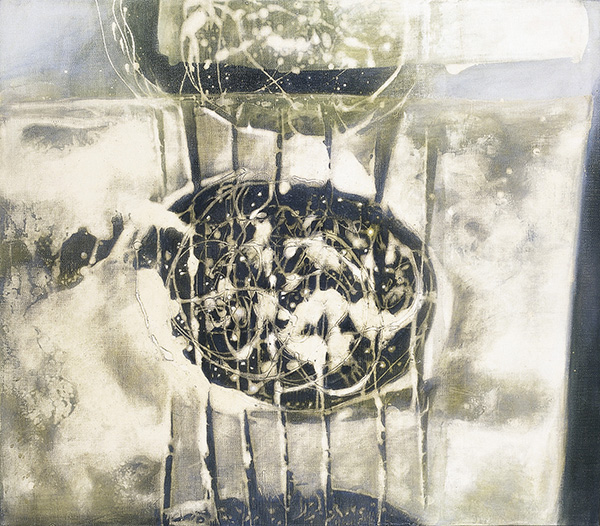
The spectrum, 1960
Oil on canvas, 80 x 70 cm.
Private Collection.
1937 - 1965
The "Huraño" Of The Buses
Nicolás García Uriburu was born in Buenos Aires on Christmas Eve, December 24, 1937. He is the eldest of ten children, nine of whom still live. His father, Eduardo, was a talented lawyer with a strict sense of discipline. His mother, a practicing Catholic, was endowed with an equally strict sense of duty. Naturally, this twin equation of spiritual and practical morality marked the rhythm of life in the family home.
Traditionally, summers were spent in the countryside. Nicolás and his mother used to visit his aunts for a few days, permitting him to get in contact with nature. But then the destination would change and the Uriburus went instead to the seaside, to a house that his father had bought, located six kilometers north of Mar del Plata, 150 meters from the beach. Since the city of Mar del Plata was spreading toward the south, the Uriburus find the same isolated life they lead in the city at the seaside. His father looks after the garden with the same frenzy he displays when working in Buenos Aires. The sea, the wind, and the salty water stunt the growth of the plants. By dint of trimming, he succeeds in making them grow into trees.
This domestic isolation affects the child’s character deeply. Nicolás becomes introverted and reserved. He is a loner, a “huraño,” within his own family. However, something outside of his home arouses his interest, and this occurs at school. His teacher has noticed he has a gift for drawing, and on the occasion of Argentina’s dual independence days, May 25 and July 9, she invites him to the blackboard to draw the Cabildo of Buenos Aires and the House of Tucumán, two of Argentina’s most revered buildings. Nicolás realizes that his classmates look up to him with admiration and manages to get his teacher to repeat the invitation every year.
Nicolás wants to become a painter and devote his life to art. That youthful dilettantism which one renounces on starting a family is not for him. It takes more than just being carried away with one’s own natural talent to become a Braque or a Modigliani. Nicolás will apply himself to painting, the art form that is the flesh of vision. Soon his canvases will pile up in his room on Salguero Street. He takes part in every art competition. In 1958, he starts to study architecture to appease his father, and there he meets Luis Benedit, who becomes his friend. Together they are to pursue parallel artistic careers until they leave the university.
From a work like Espectro [Specter, 1960] onwards, a dark texture with earthy hues (beige, ochre, brown) will, little by little, construct a mass, and shape outlines in undulating waves, in geological cross-sections, in Azteclike step terraces. This process of integrating the texture of his materials with nature culminates in 1962 in his Pampas series. The emerging of the horizon, which coincides with a range of brighter colors (beige gradually turning into yellow, and gray then becoming blue), ends in an exaltation of flat perspectives. The sense of expanse is affirmed by the profile of an essence-filled landscape that joins space and light: Pampa y cielo [Pampa and Sky], with its blues, pinks and greenish-yellows, Río de la Plata [River Plate], with the triple horizontality of its structure (sky, earth, water), are good examples of an organized vision of nature, the ultimate product of an organic and sensorial experience rendered in terms of visual symbols.
The conclusion that can be drawn from this evolution is clear: direct contact with nature dominates the artist’s period of solitary development and leaves its mark on him in his short foray into informalism; and, step by step, the imprints of the amalgamation of the texture of his materials and nature are organized into fragments of an essential landscape. In 1963-1964, a return to figurative painting begins and is consolidated in trees and ombúes, the treelike plants of the Argentine pampa. At the same time, his treatment of materials is refined. Atop the red background, green steadily gains strength, stressing the symbolic value of form. The foliage of the ombú, with its muted chromatic textures, appears as a microcosm set in the soil, a reminiscence of the essential landscape.
© Copyright Uriburu – Pierre Restany
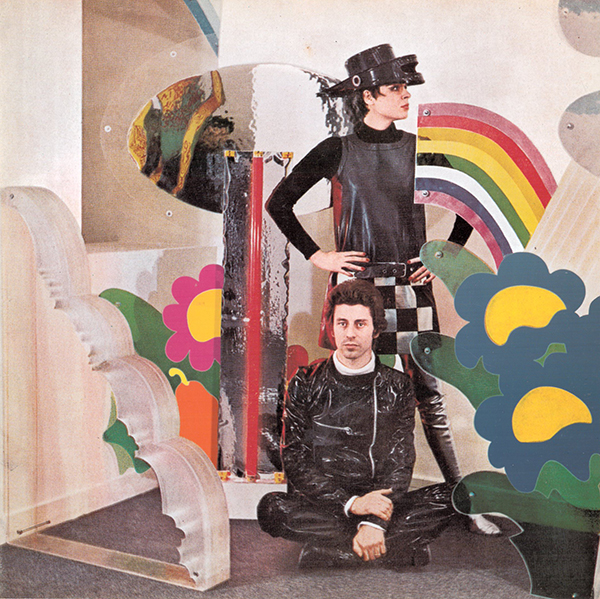
Nicolás and Blanca at the opening of Prototypes of an artificial garden,
Iris Clert Gallery, Paris, 1968
FNGU Archive.
1965 - 1968
Parisian Arcadia
In 1965 the French Embassy awarded him the Braque Prize, which entitles him to spend a year in Paris. Before leav-ing, however, he wants to finish his training as an archi-tect. In the end, I happened to meet him at the Instituto DI Tella. Romero Brest, who had been indifferent to his work, really liked his colectivos and even invited him to take part in a group exhibition at Guernica Gallery, to-gether with four other artists, one of whom was David Lamelas. We greeted each other. I congratulated him for his colectivos, and we agreed to meet soon in Paris.
The Uriburus quickly adapted to the Parisian art world. At first, to make ends meet, Blanca worked with Castillo and then became a fashion model for Pierre Cardin. When Cardin opened his Espace on Avenue Gabriel, she was placed in charge of cultural contacts, especially those with Latin Americans.
“In January 1967, Nicolás invited me to his studio to see the paintings for his February 10th inauguration at Iris Clert’s, my initial smile becomes a cry of joy. Painted in the same effortless style of the colectivos, effigies of Marie Antoinette parade before my astonished eyes. There are portraits to please every taste: Marie Antoinette with a rose or with cats, as Diana the Huntress or as a shepherdess, and all these in a delirium of bright colors, flat surfaces, and extravagant neo-baroque ornamentation, worthy of Carnival in Rio de Janeiro! Marie Antoinette surrounded by her spiritual sisters, Agnès Sorel, and Du Barry, Montespan and Pompadour, Diane de Poitiers and La Vallière … Capets everywhere!” Pierre Restany.
In 1968, he exhibited “Prototypes for an Artificial Garden” at the Iris Clert Gallery, an innovative exhibition that combined natural elements with modern materials and was attended by major figures in the art scene, such as Salvador Dalí. Uriburu’s exhibit produces a great impact. On a superficial level, the provocative thrust of a gesture causes sensation. The painting depicting the escape to Varennes, with the King and his family sitting at a table before a bottle of Coca-Cola, arouses sarcasm in worldly journalists such as Philippe Bouvard, who does not miss a trick in his chronicle in Le Figaro: “The painter of Louis XVI loses his head.” All Paris, not just the jet set, is talking about the exhibition. After the explosive appearance of New Realism and its method of appropriating urban nature, painting is in crisis, or rather, the painted image is beginning to doubt itself. Those who favor narrative figuration try with difficulty to defend its survival.
Uriburu’s yéyé preciousness arrives at just the right moment to demystify genre painting. If it is seen with ingenuity or through “the innocent eyes of American Indians with no past,” as Nicolás instinctively feels that Paris, unknowingly, is sitting on top of a volcano. In the meantime, this drowsy Paris with its yéyé humor has accepted the young Argentine artist who so wittily takes liberties with history.
The Capets’ favorites bring him luck. Although he was the last to arrive, he knew how to seduce the ladies. Tout-Paris of the art world adopted and pampered him. On February 27, while his works are still on exhibit, he learns he has been awarded the Prix Lefranc, the most “in” prize of the 1960s. Among the members of the jury are figurative and New Realist artists. However, the most important juror is César, the protagonist of compression, who is now experimenting with expansion and moving from metal to plastic. César’s sponsorship constitutes a true baptism into the jet set of art.
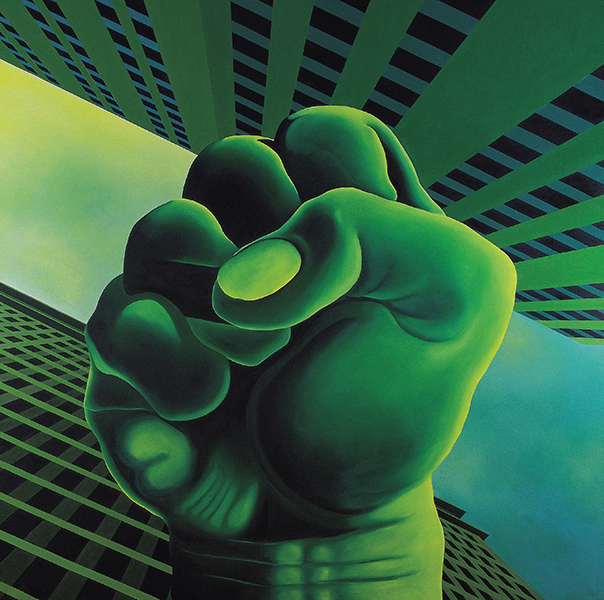
The Rebelleion (Fist), 1973
Oil on canvas, 190 x 180 cm.
NGU Estate.
1968 - 1976
Green Power
García Uriburu lived in New York with his wife Blanca during most of 1969. As the artist explained, his reflections on the tension between nature and culture began in the city, and they materialized in a series of paintings with skyscrapers or emblematic buildings in the background and images of animals, many in danger of extinction, superimposed in the foreground. At that time, his concern for environmental issues also emerged, an interest that would remain prevalent through to his last works. In this context, he turned his attention to Latin America. Toward the end of the year in 1970 he began to paint a map of the region, which he left unfinished. He completed the work in 1981, by incorporating a line that united the entire continent by way of its river basins. On a dominant, turquoise field, a yellow line highlights the Belem-Buenos Aires route, traced along the Amazon, Orinoco and Río de la Plata rivers. With this piece, Uriburu initiated a phase in which maps would be decisive in his creative propositions.
Beginning in the early ‘60s, the idea of Latin America as a shared space of identification had gained visibility on a global level. Over the course of that decade, the perception that the conditions were ripe for an unprecedented, historical leap forward also prevailed: one where the continent would take a turn toward socialist experiences based on the Cuban Revolution model. This alternative implied many of the concepts and processes making up the global political map since the ‘50s: emancipation of the countries denominated as third-world, anti-imperialism and renewed conceptions of the Left which included armed struggle as a political option in its most radical strains. Influenced by this atmosphere of transformation, different artists recovered the image of the map of Latin America with ideological implications. While maps have been a form of constructing knowledge and a shared code for geopolitical representation throughout the modern era, in the context of third-world proclamations and struggle that extended up to ‘70s, they functioned as a powerful visual cornerstone of identity. Clear reference was made to Joaquín Torres García and the inverted map he conceived for his 1935 manifesto, School of the South, and in many cases, a direct link was made between pro-Latin American positions from the first half of the 20th century and the revolutionary ideals that marked the region mid-way through the ‘60s.
© Copyright Venecia en clave verde. Nicolás García Uriburu y la coloración del Gran Canal. Curator: Mariana Marchesi.
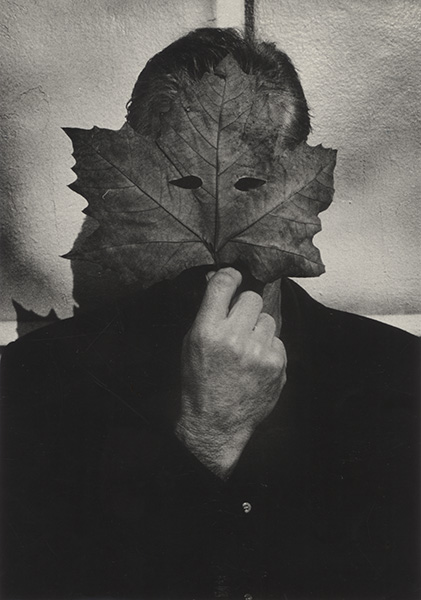
Defense of tree at Casa Álzaga.
Portrait of Nicolás García Uriburu by Aldo Sessa.
Plantations
Ecological commitment, a fundamental motivation in Nicolás’s work, fueled his fight for the preservation of urban green spaces in the City of Buenos Aires. In 1971, he defended the jacaranda trees in Plaza Chile through open letters in the press, a method he repeated in 1980 to prevent the felling of century-old plane trees in Plaza Grand Bourg. These were gestures that accelerated the ecological awareness of authorities and residents.
In 1981, Joseph Beuys asked Nicolás to participate in a campaign against the pollution of the Rhine River in Germany. Documenta 7 took place in June 1982, where Beuys carried out his tree-stone plantings and invited Nicolás to plant the first tree in a series of 7,000 oaks planted in Kassel, Germany.
The artist initiated a series of simultaneous plantings in Uruguay and Argentina. During the years 1984-1988, he designed a comprehensive plantation program on both sides of the Río de la Plata. In December 1984, Uriburu traveled to Punta del Este to meet with the Bosque Foundation, a group whose objective was to reforest the entire area. The group elected him as its president, and they proceeded to carry out the initial plantings. Over 600,000 pine trees have been planted.
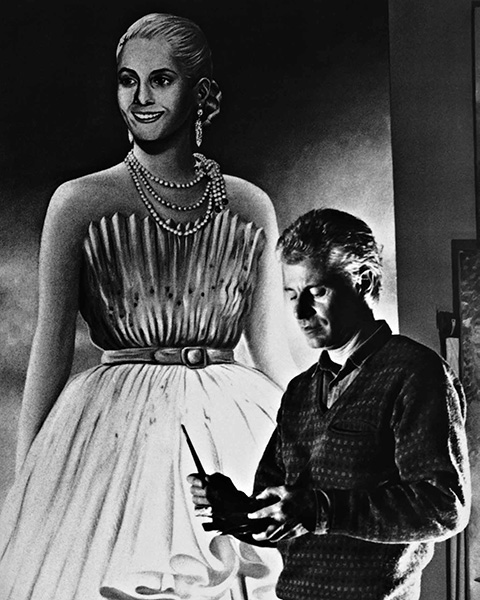
Nicolás painting Eva Perón (9 July 1950), 1972
Oil on canvas, 270 x 190 cm
NGU Estate.
1983 - 1990
The Return To Democracy:
Argentina And Its Myths
The Green Man, who left his mark on the waters of half the world, thus carries out his first coloring in Argentina under exceptional conditions: a good omen! Uriburu juxtaposes the triangle of democracy with the scheme of continental totality, the triangle of unitary South America, which includes two other triangles within its mass: that of Argentina and that of the Southern Cone.
The most haunting memory is that of the collective. Not one of those he painted in 1965, but a real one, as they no longer exist today: the one he took every day to go to school between 1945 and 1955, during the Perón years. The one that went down Las Heras towards Belgrano. These are the myths of his childhood, which he shares with thousands of other Argentinians who take the bus, but which truly belong to him because he spontaneously identifies with them, just as he does with the blue-white-blue flag, with tango, and with the Mass.

Nicolás García Uriburu designs a program of native tree plantations on both sides of the Río de la Plata.
NGU Estate.
1990 - 2016
Bolivar's Dream
Beginning in the early ‘60s, the idea of Latin America as a shared space of identification had gained visibility on a global level. Over the course of that decade, the perception that the conditions were ripe for an unprecedented, historical leap forward also prevailed: one where the continent would take a turn toward socialist experiences based on the Cuban Revolution model. This alternative implied many of the concepts and processes making up the global political map since the ‘50s: emancipation of the countries denominated as third-world, anti-imperialism and renewed conceptions of the Left which included armed struggle as a political option in its most radical strains.
Influenced by this atmosphere of transformation, different artists recovered the image of the map of Latin America with ideological implications. While maps have been a form of constructing knowledge and a shared code for geopolitical representation14 throughout the modern era, in the context of third-world proclamations and struggle that extended up to ‘70s, they functioned as a powerful visual cornerstone of identity. Clear reference was made to Joaquín Torres García and the inverted map he conceived for his 1935 manifesto, Escuela del Sur [School of the South], and in many cases, a direct link was made between pro-Latin American positions from the first half of the 20th century and the revolutionary ideals that marked the region mid-way through the ‘60s. One of the most direct citations is the image Argentinean Luis Felipe Noé proposed for the book El arte de América Latina es la Revolución [Revolution is the Art of Latin America], which can be understood as an anti-imperialist declaration where inverting the map meant subverting the relationship of domination on a symbolic level. In the cartographies proposed by Uriburu, Latin America emerged as hope for the future. In them, water was the natural element of union between vast territories with a history in common.
Following the coloration of large rivers, the second phase of my art takes on more complete and political meaning […]. Uniting the countries of Latin America through the waters of its rivers, but not inside the boundaries established by man. An entire continent united by nature. Water, earth and the air are the reserves of the future on the Latin American continent. An art of Latin American dimensions.
The issue of Latin American integration that is always present in regional debates can be traced back to the era of independence and Bolívar’s ideal of a united continent. In this sense, the fluvial connection had been a motive for numerous expeditions destined to explore the internal communication between the continent’s waterways that had been ongoing since the 19th century. Among many others, Alexander von Humboldt expressed his interest in “the integration of the rivers of the South” in his memoirs of the Royal Orinoco expedition.
The ideals of Latin American union that characterized the region beginning in the ‘70s also contemplated the possibility of political, economic and social development projected for the continent along with emancipation from world powers. Integration was no longer being considered in symbolic terms only. In late 1979, the Rumanian brothers residing in Venezuela Paul and Constantino Georgescu undertook an expedition, determined to demonstrate the viability of continual fluvial navigation along the North-South axis by way of South America’s three large hydrographic systems: the Orinoco, Amazon and Río de la Plata river basins.
On May 15, 1980, the expedition reached Buenos Aires, the voyage’s southernmost point. Almost one year later, Paul Georgescu set out on a new voyage, denominated Amistad e integración sudamericana [South American Friendship and Integration], which departed from the Puerto de Tigre in the province of Buenos Aires on January 13, 1981. Its purpose was to connect eight of the continent’s thirteen capitals via waterways.
At the same time, García Uriburu returned to work on the painting he had laid out ten years earlier, where he had delineated the “natural map”, and finished it with the title Latinoamérica unida por los ríos [Latin America United by Rivers].
Between 1973 and 1974, García Uriburu composed a series of maps in which the political boundaries were erased in order to emphasize natural limits. He stated, “Rivers are the arms of continental union that surpass those boundaries”. By erasing them, he was proposing to view the territory from the standpoint of nature: by subverting an established code, he suggested the nature-culture opposition through geography. At the same time, these images were powerfully charged with symbolism, given that in questioning political order, the artist also stripped the map of the neutrality assumed to exist in cartographic practice, that is, its capacity to be understood as a representation of reality as a given.
© Copyright Venecia en clave verde. Nicolás García Uriburu y la coloración del Gran Canal. Curator: Mariana Marchesi.

Portfolio Cover (Manifesto), 1973
Silkscreen on paper, 76,2 x 56,5 cm.
NGU Estate.
1973
Manifesto
In 1973, Uriburu produced a portfolio of screen prints that he titled Portfolio (Manifesto). He made it a compilation of his ideological universe in ethical as well as aesthetic terms, with a powerful dialog between text and images (almost all of the prints bear some sort of inscription on the image). It consists of six screen prints that revise and put in order his production during the five-year period that had changed his aesthetic perspective. Venice was once again the point of departure, to which the artist added the intercontinental coloration project that he had carried out in 1970. He gave prevalence, however, to an initiative that was never brought to fruition: the Coloración de las Cataratas del Iguazú [Coloration of Iguazú Falls], the print that concludes the series. In this way, he set his view of the future on Latin America, whose central role is manifested in the two maps included in the portfolio. On one of them, he chose to inscribe a new proclamation, condensing his intentions in just a few lines:
“By way of my art, I denounce the antagonism between nature and civilization. This is the reason why I color my body, my genitals and the waters of the world. The most evolved countries are destroying the water, the earth and the air; the reserves for the future in Latin American countries.“
The second map was a screen print of one of the four maps he had painted in 1973, with the text “Latinoamérica. Reservas naturales del futuro. Unida o sometida”, paraphrasing Juan Domingo Perón’s words from the book La hora de los pueblos [The Hour of the People], as Isabel Plante explains, pointing out the way in which the artist conjugated “his concerns regarding environmental issues with the idea of Latin American unity […]”. Finally, one of the prints was introducing the importance of the body in performative terms in the coloration experiences: it returned to the action Uriburu had developed in October of 1971 while he was in New York, when he intervened his genitals by painting them green and photographing them. Some time later, as Restany relates, he mailed a copy of the image to his friends.
© Copyright Venecia en clave verde. Nicolás García Uriburu y la coloración del Gran Canal. Curator: Mariana Marchesi.

